There are few firearms that have excited me like the new Colt King Cobra. Though it stretched the budget, I listened to Mike’s advice and purchased my T&E sample, and I’m so glad I did. This three-inch, “Goldilocks” .357 has become one of my favorite handguns period, and certainly my favorite carry revolver. Colt has expanded the King Cobra line with the 2″ King Cobra Carry, a 2″ DAO model and the subject of this review, the Colt King Cobra Target.
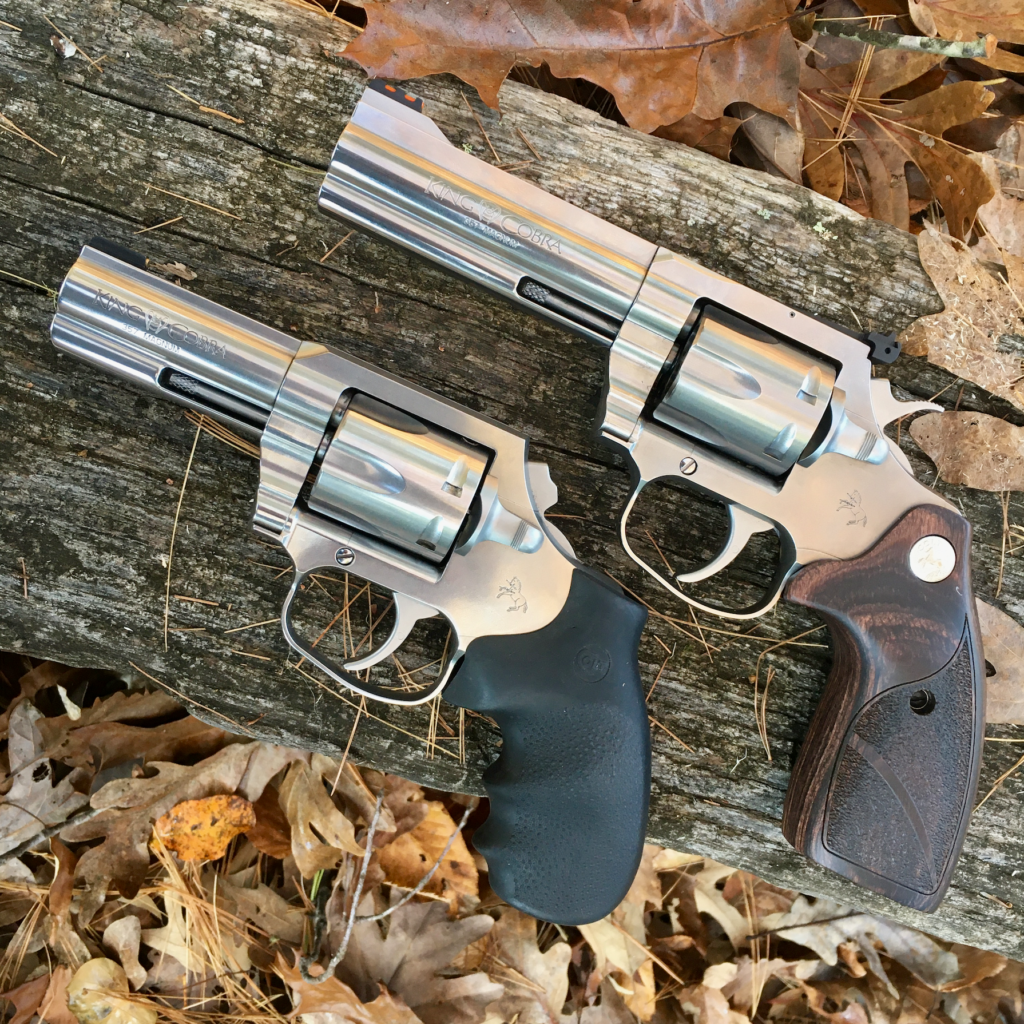
I conducted this review in accordance with our Field Report Standard Operating Procedure. I did deviate from our S.O.P. slightly; again, for want of a holster, I was unable to carry the Colt King Cobra Target, and am thus unable to report upon this aspect of this revolver.
Colt King Cobra Target
The Colt King Cobra Target is very similar to the previously-released King Cobra, but with some noticeable differences. The frame is the same modified D-frame, it is still stainless steel, and chambered in .357 Magnum. The most obvious differences are the King Cobra Target’s longer, 4-inch tube and its adjustable sights. Also like the King Cobra, in-depth media coverage has been scant; we are again proud to give the King Cobra Target our undivided attention here!
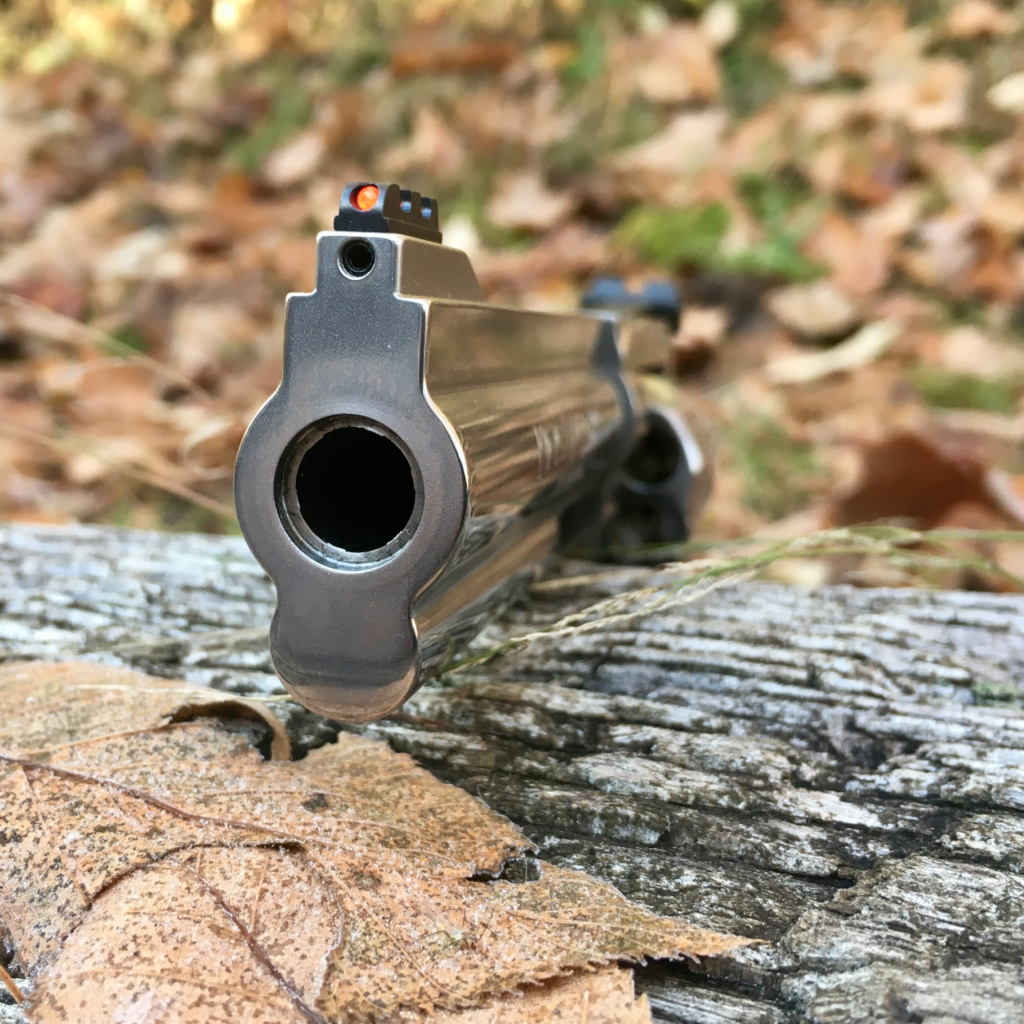
The King Cobra Target’s 4″ tube features an underlug that runs its entire length. While the tip of the 3″ King Cobra’s underlug is relieved to ease its entrance into a holster, no such accommodation is made here. A hefty rib also runs along the top of the barrel, adding additional, nose-forward weight. The muzzle crown is deeply recessed and the front sight sits atop a comparatively lofty pedestal. The front sight on the Target model is a replaceable, red fiber optic. I will address sights in greater detail further down the page.

Both the top of the barrel and the frame’s top strap are conspicuously flat and unadorned. they combine to form a single, long slab of metal that scans as a bit inelegant, though I admit that after handling it for just a couple of weeks I hardly notice it. This is just one of those cosmetic choices that will appeal to some and not to others, and that is ultimately secondary to function. The top strap and top of the barrel are subdued to reduce glare.
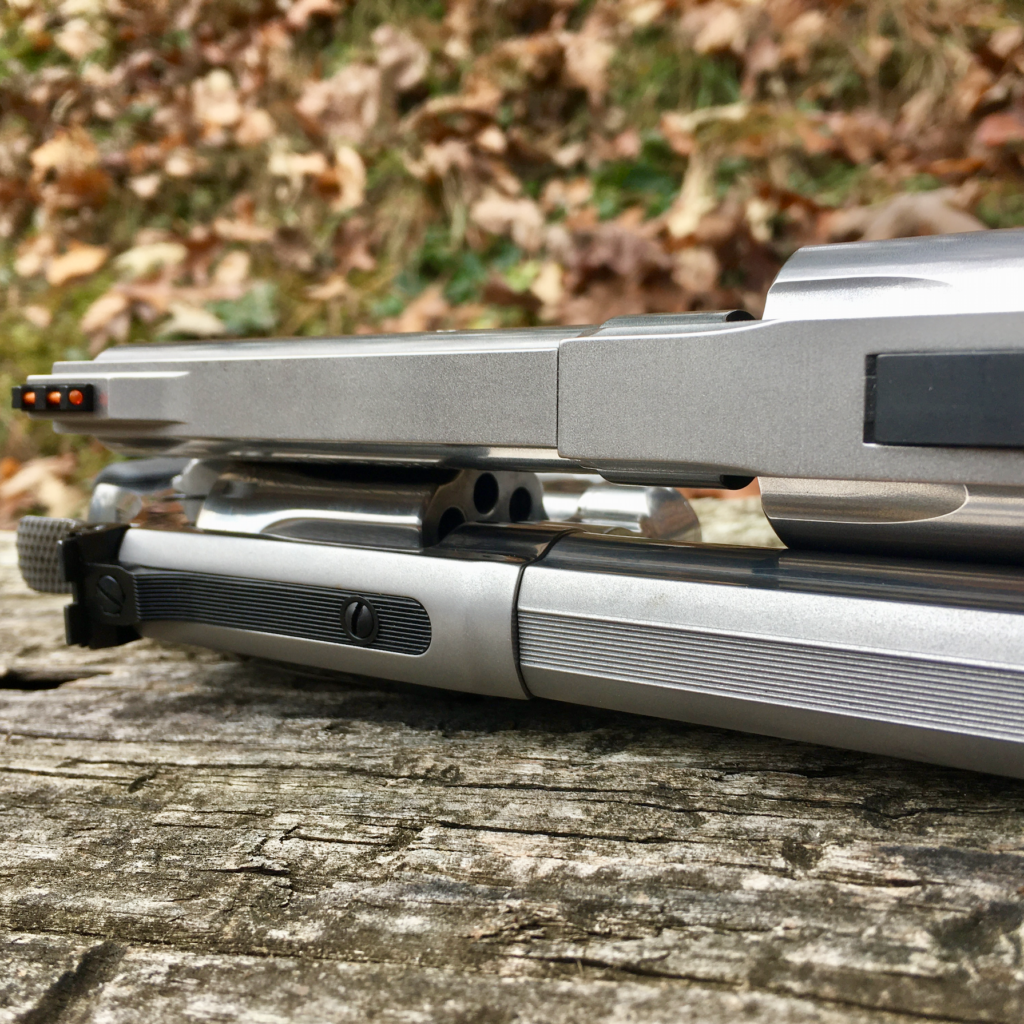
The rear of the topstrap is milled to accept the adjustable rear sight, which I will detail further along in the review. The “small” frame is consistent with the remainder of the King Cobra line. It boasts a 6-shot, .357 Magnum cylinder which is opened via Colt’s rearward-activate cylinder release latch. The trigger guard is enlarged to accepted gloved fingers, and the grip frame is the same small grip frame found on the standard King Cobra. I like this as it allows almost infinite flexibility in grip size.
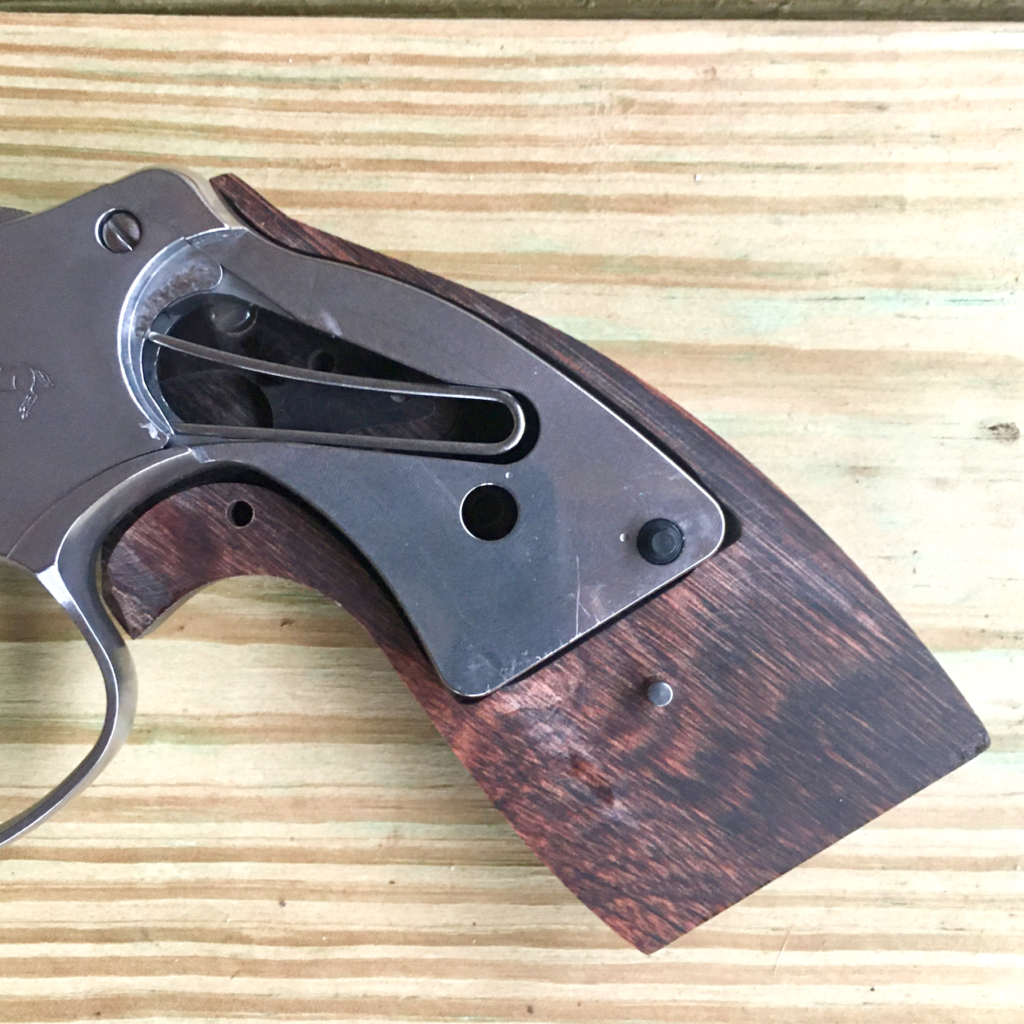
With it’s higher sight line and larger grips, the King Cobra Target is almost a dead ringer for a K-Frame revolver. This is an excellent size; while technically designated a small frame, it handles and shoots like a “real” revolver.
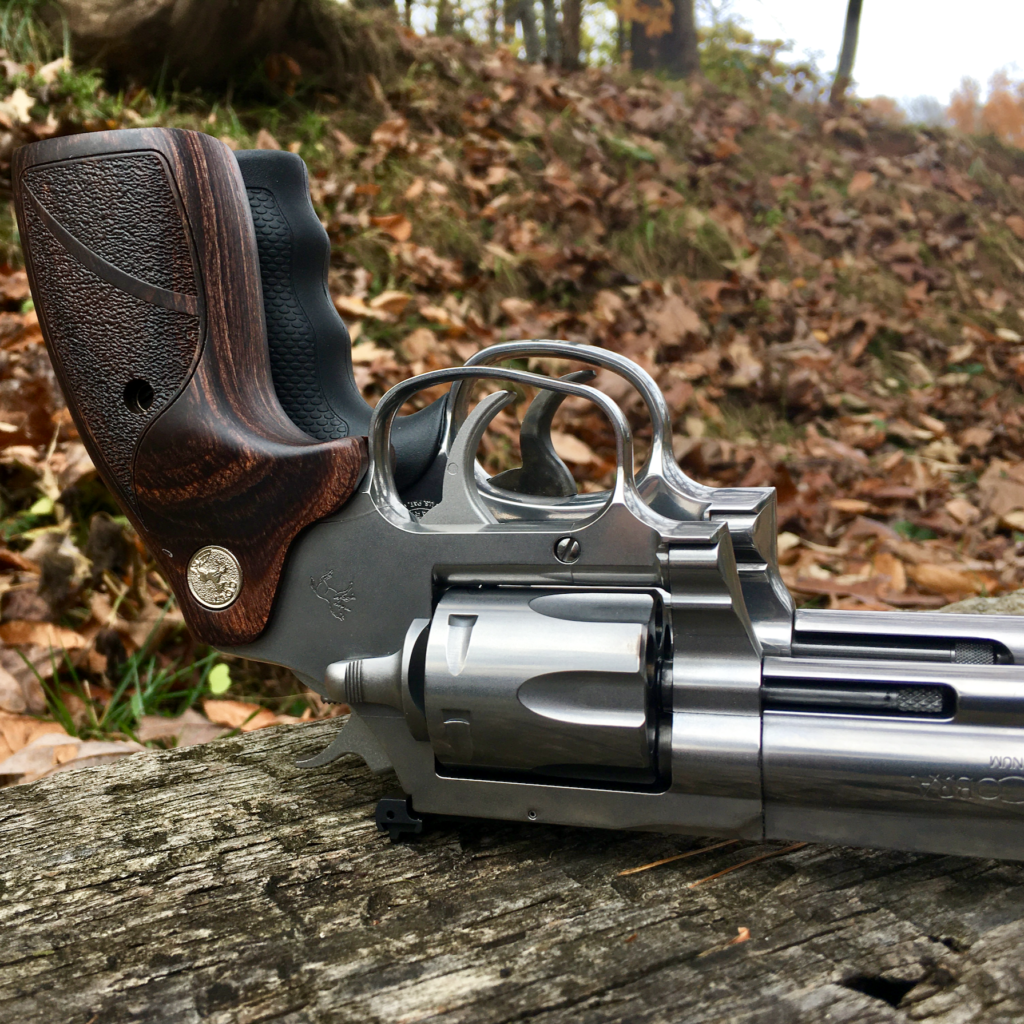
Grips
The King Cobra Target ships with wooden grips. I will admit they’re quite handsome and extremely well-fitted. The fitment of the seam is so tight that I had to look a couple times to ascertain that yes, there are two panels. The tops of the panels are deeply relieved and accommodate speedloaders nicely. Both sides bear a silver Colt medallion. I found that the two medallions on my exemplar did not line up with each other, with the one on the left being tilted about 1/8th of a turn forward, relative to the one on the right.
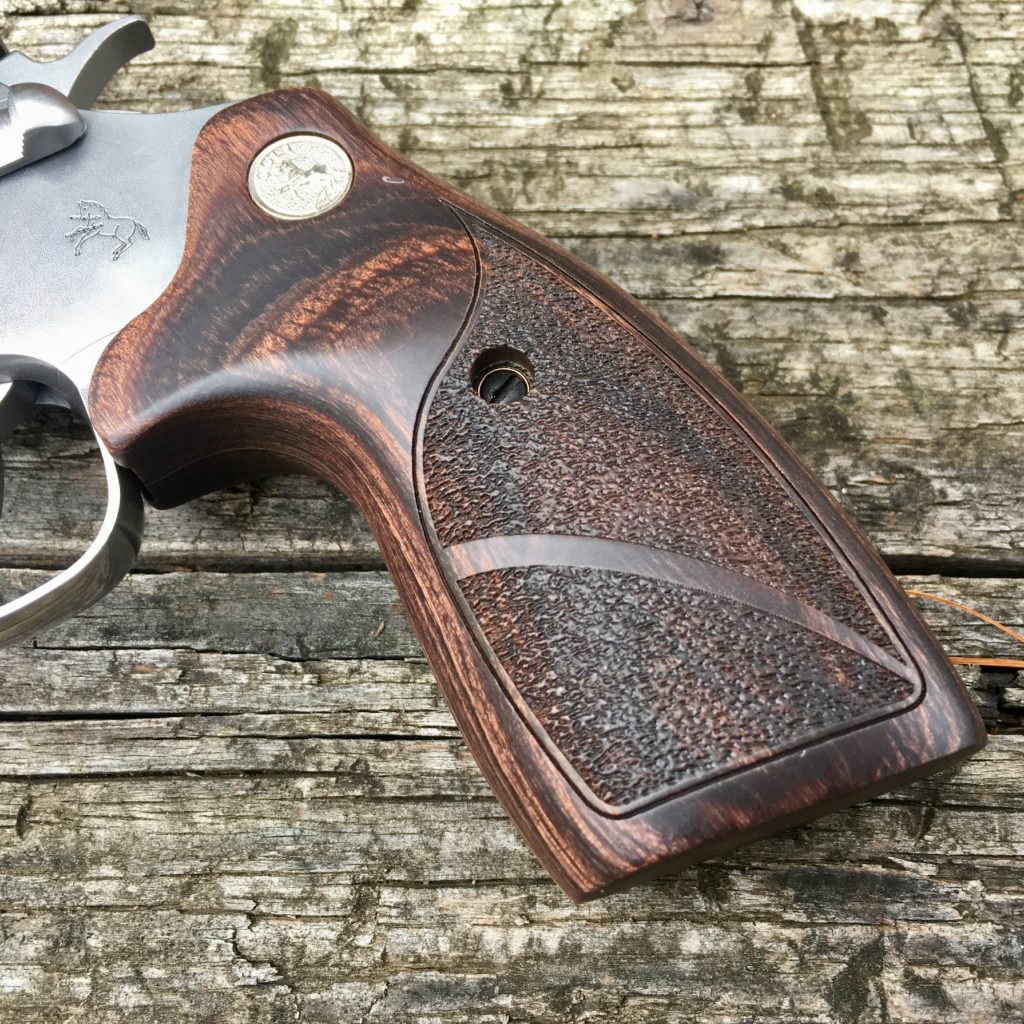
Though this is a good looking grip, I did have some issues with it. First, the stippling seems to be mostly decorative. If it covered more (much more) of the grip’s surface it might offer some purchase but as-is, this is a slick grip. Secondly, the shape of the grip is not ideal, at least for me. The lower portion of the grip offers a notable, palm-filling swell that feels quite good.
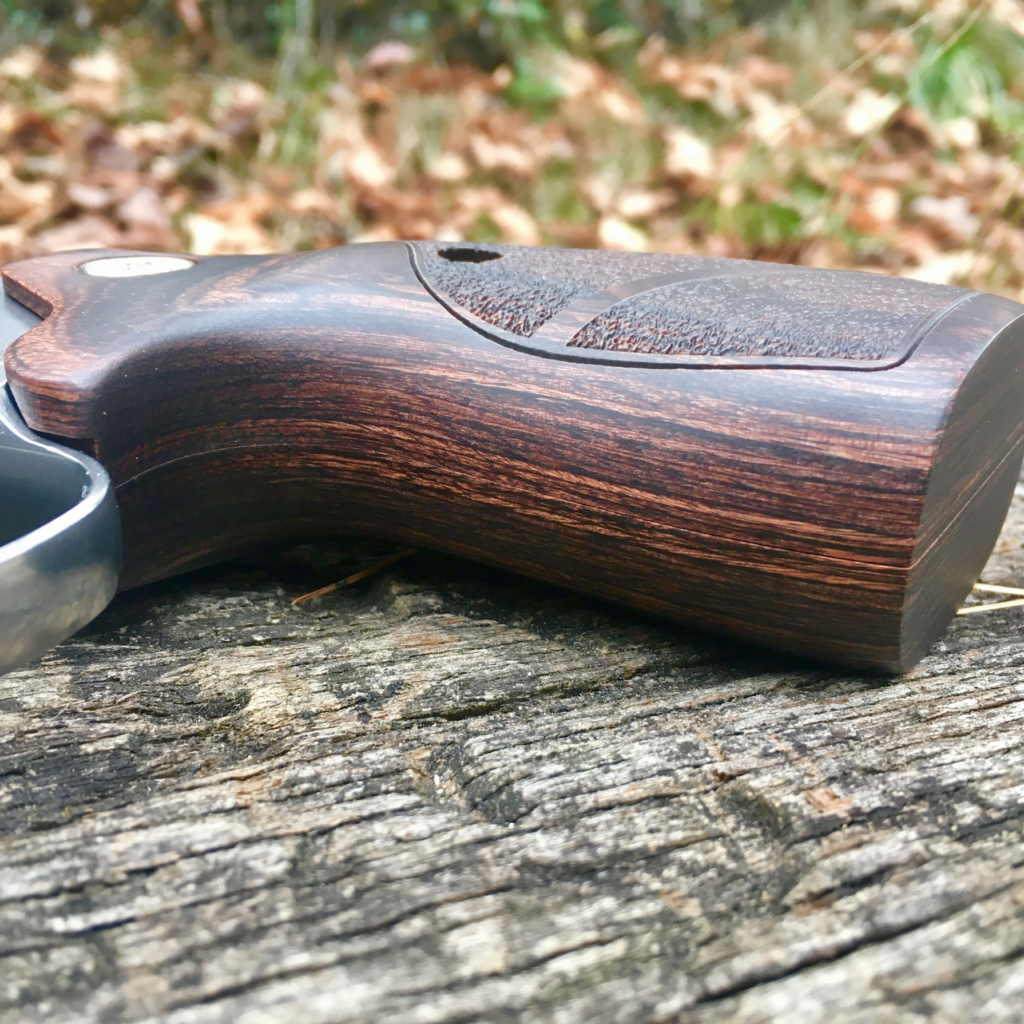
However, the upper portion of the panels narrow significantly. I found that while shooting my hand had a tendency to drift higher and higher on the “neck” of the grip. By ‘tendency’ I mean that no matter how tightly I held on, my hand still ascended up the grip. This resulted in my index finger at a fairly severe angle in relation to the trigger. This made pulling the trigger a “up-and-to-the-rear” proposition rather than straight back to the rear. If your hands are sized differently than mine this might not be an issue, but I found it to be intolerable.
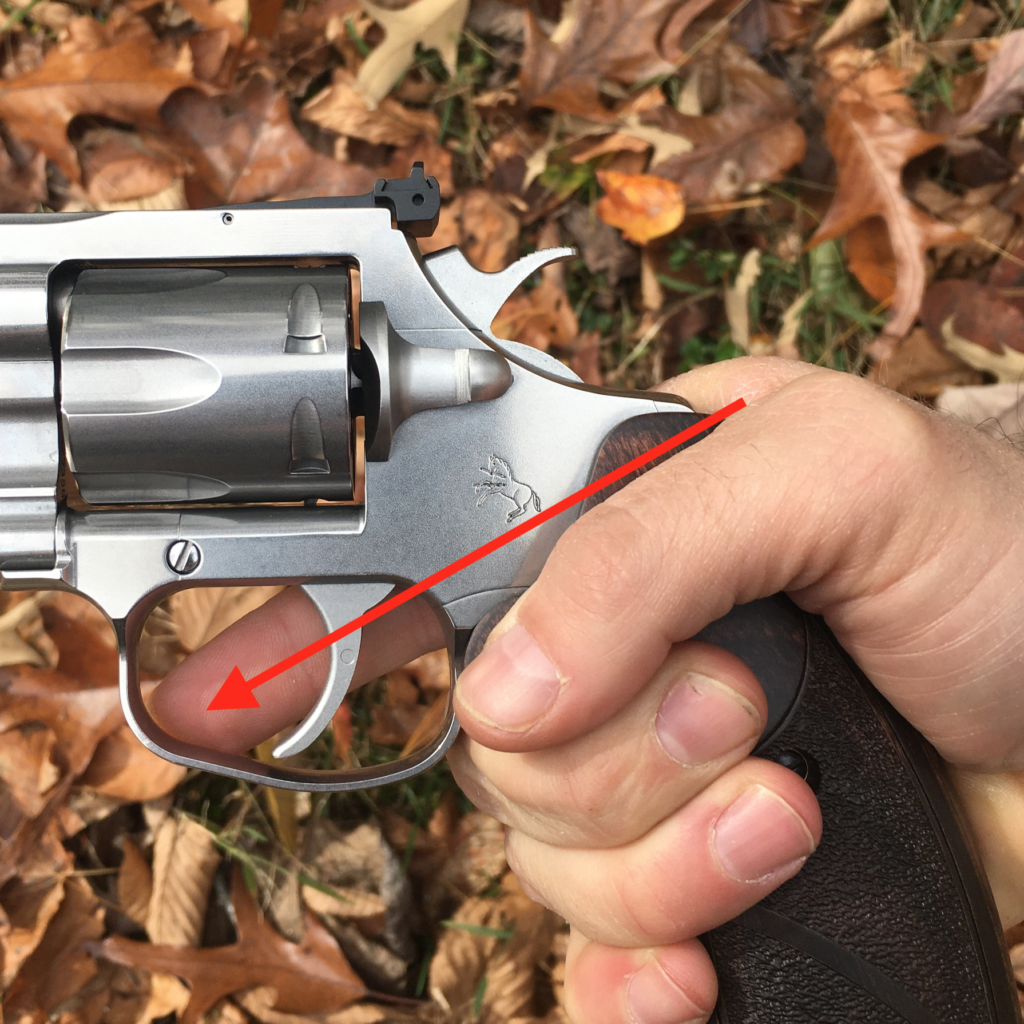
I did find that the grip felt very good when grasped near the bottom. This placed my trigger finger in in near-perfect relation to the trigger. Unfortunately, this grasp is takes a somewhat deliberate effort, and one I doubt I could reliably replicate under pressure. Nor, as I mentioned earlier, can I maintain this grasp under even mild recoil. Further, it leaves the hand low on the grip frame, unnecessarily raising the bore axis.
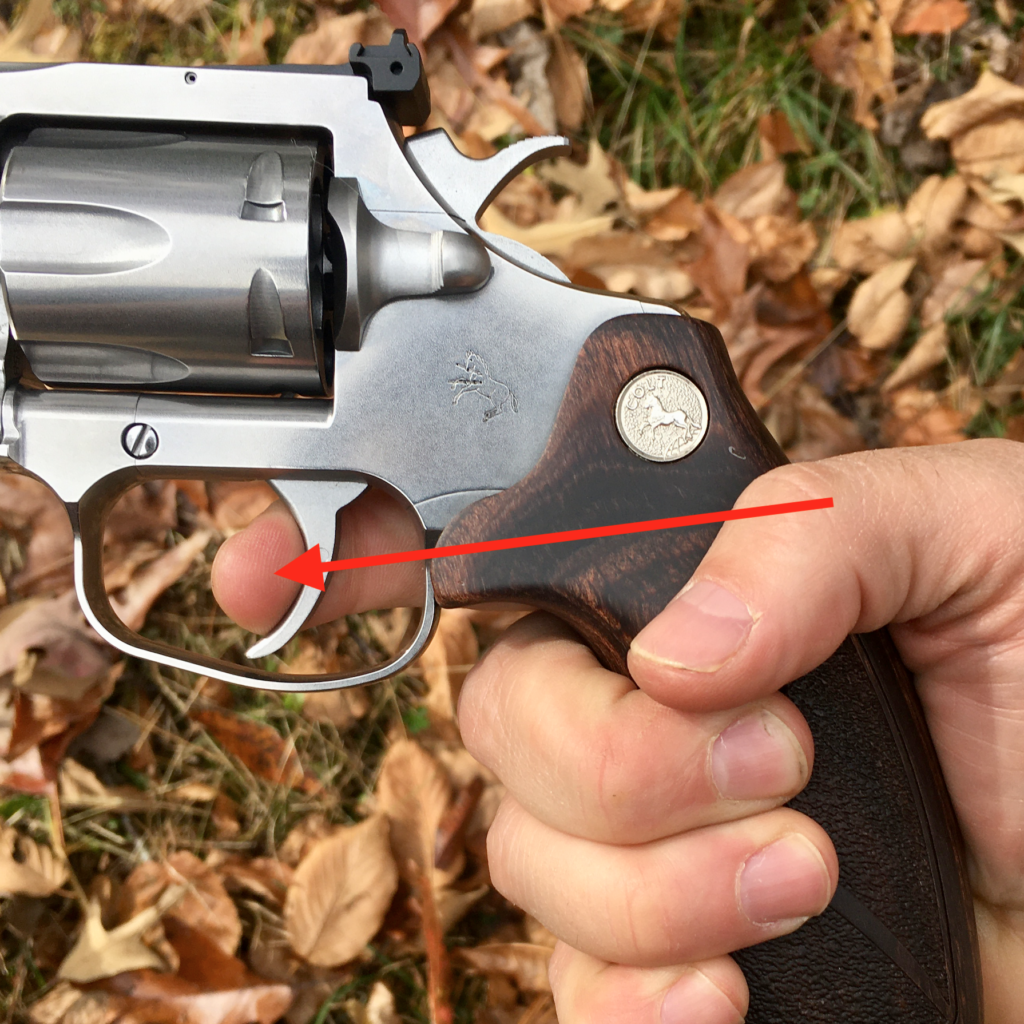
This style of grip may be intentional as this is a “Target” model that is perhaps intended for a good deal of single-action shooting. However, I feel the utility of the King Cobra Target extends well beyond the target realm and it will doubtlessly be used as a home defense, trail defense, and possibly even concealed carry revolver. Were I to use it in one of these roles replacing the grip would be imperative. I swapped the Hogue Monogrip from my King Cobra onto the King Cobra Target early in the first range session. It stayed on for the remainder of the shooting portion of this review.
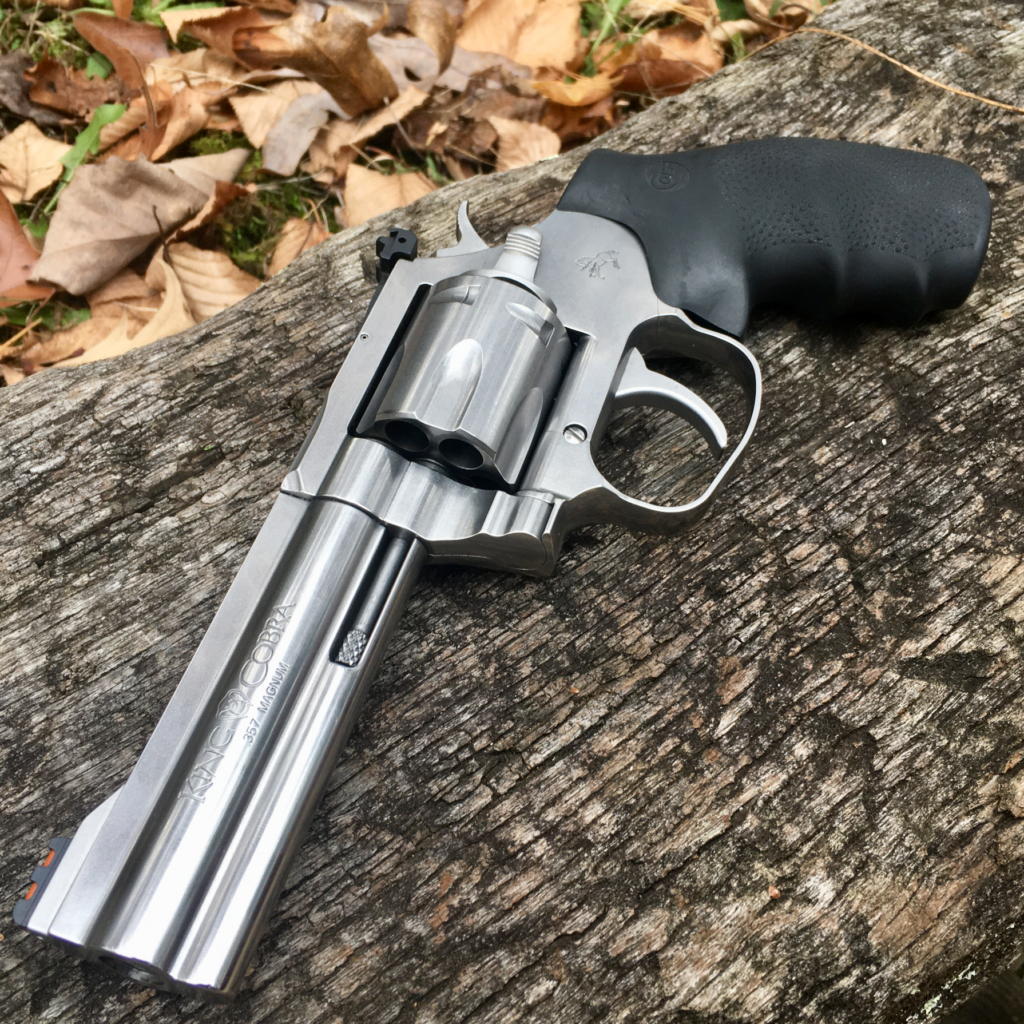
Function: Sights
In my review of the 3″ King Cobra I bemoaned the lack of adjustable sights. On the upgraded Target model, Colt has certainly delivered. The front sight on the King Cobra Target sports a fiber-optic rod. The front sight post is held on via set screw above the muzzle. It’s no secret that I’m not a fan of fiber optic sights, but the visible portion of the rod is a very clean, red circle that I found it be be perfectly usable in spite of my prejudices. Fortunately, I got the opportunity to discover that the brass bead front from the 3″ King Cobra works on this revolver, as well!
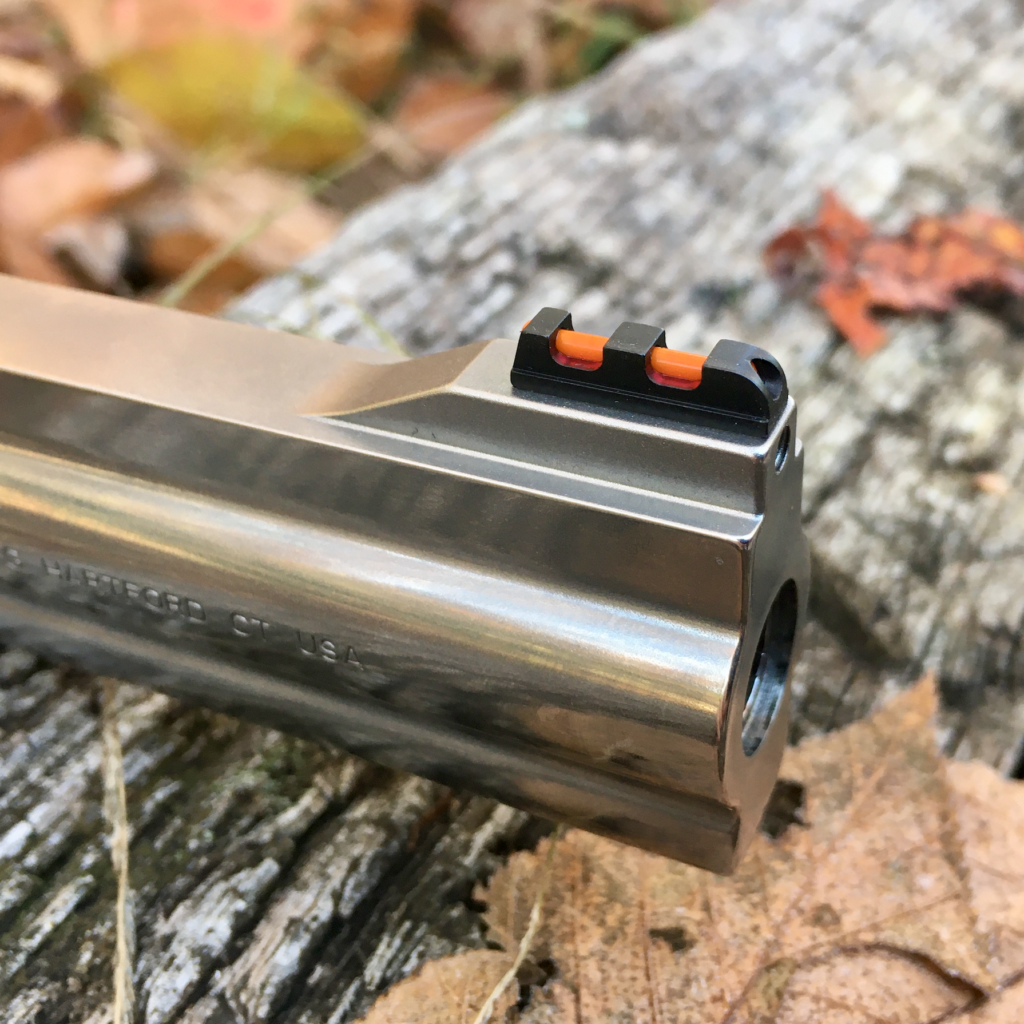
After I fired the first Dot Torture iteration I withdrew my target carriage back to my position. I recovered the target, filled in the marginal data, and stowed it. After stapling another target to the carriage I grabbed another box of ammo and loaded up. As soon as I presented the gun I knew something was drastically wrong. Then it hit me: the front sight is missing!
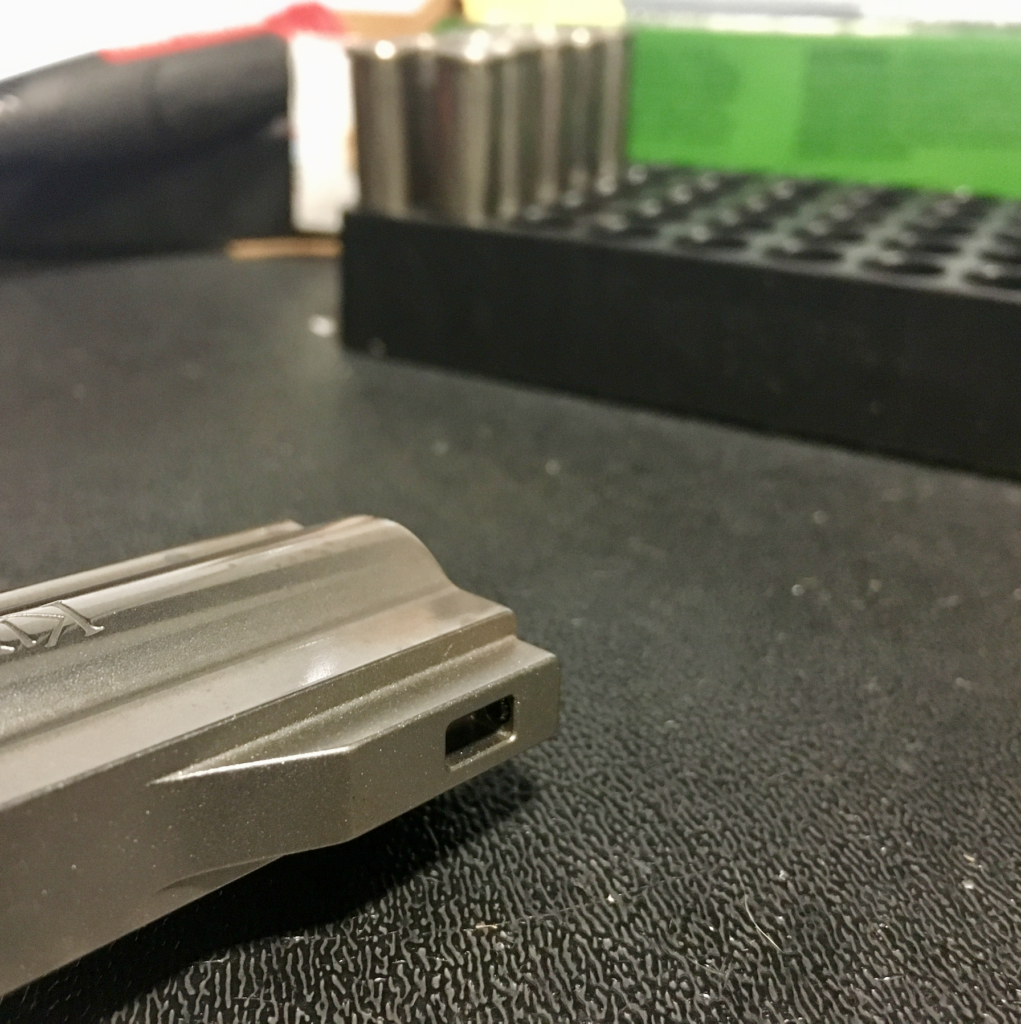
The set screw had loosened so much during the first 75 rounds of fire that the front blade had gone flying. With MacGyver-like ingenuity, I pulled the brass bead front sight off of my King Cobra and tightened it onto the King Cobra Target, and shot that way until I found the AWOL part. When I got home a dab of blue Loctite on the set screw solved the issue.
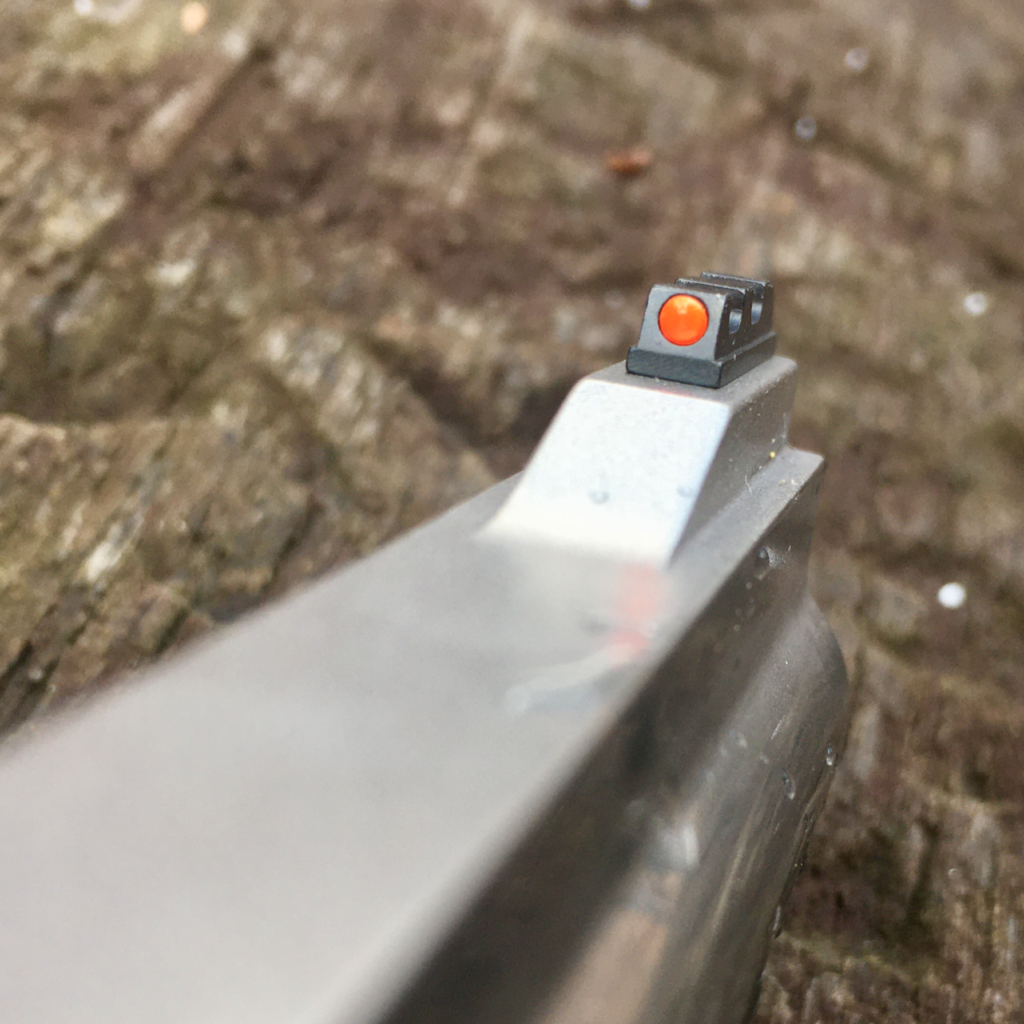
I was very interested to note that the shorter King Cobra’s brass bead worked just fine on the King Cobra Target. Sight regulation wasn’t drastically altered, and the blade was an appropriate width for the rear sight, though just a tad wider than the OEM front sight. The timing with loosing that sight is also interesting: did I really lose it on the very last round of the Dot Torture drill, or did I shoot a few rounds with no front sight†?
The rear sight is fully adjustable for windage and elevation. It provides a very nice, clean sight picture. Elevation is adjustable by loosening and tightening a screw on the top of the sight assembly. A spring forces the sight up as the screw is loosened, making for some “play” of the whole assembly; if the rear of the assembly is pressed down, it will pivot on the roll pin holding it into the frame.
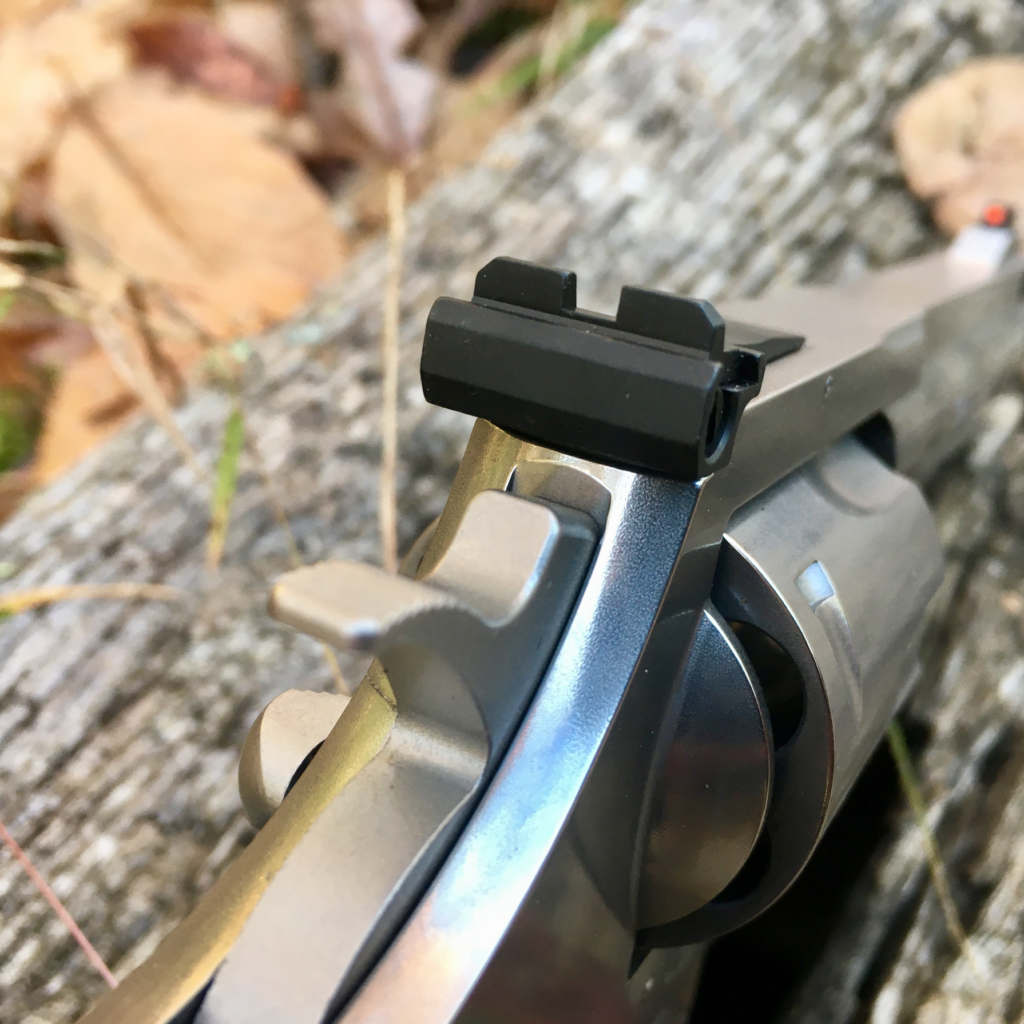
Windage adjustments are made via a screw on the right side of the assembly. In some of the groups recorded below you will notice printing to the left. Initially I did not realize that there is also a set screw to lock windage adjustments in place (the generic owner’s manual is silent on the adjustable rear sight).
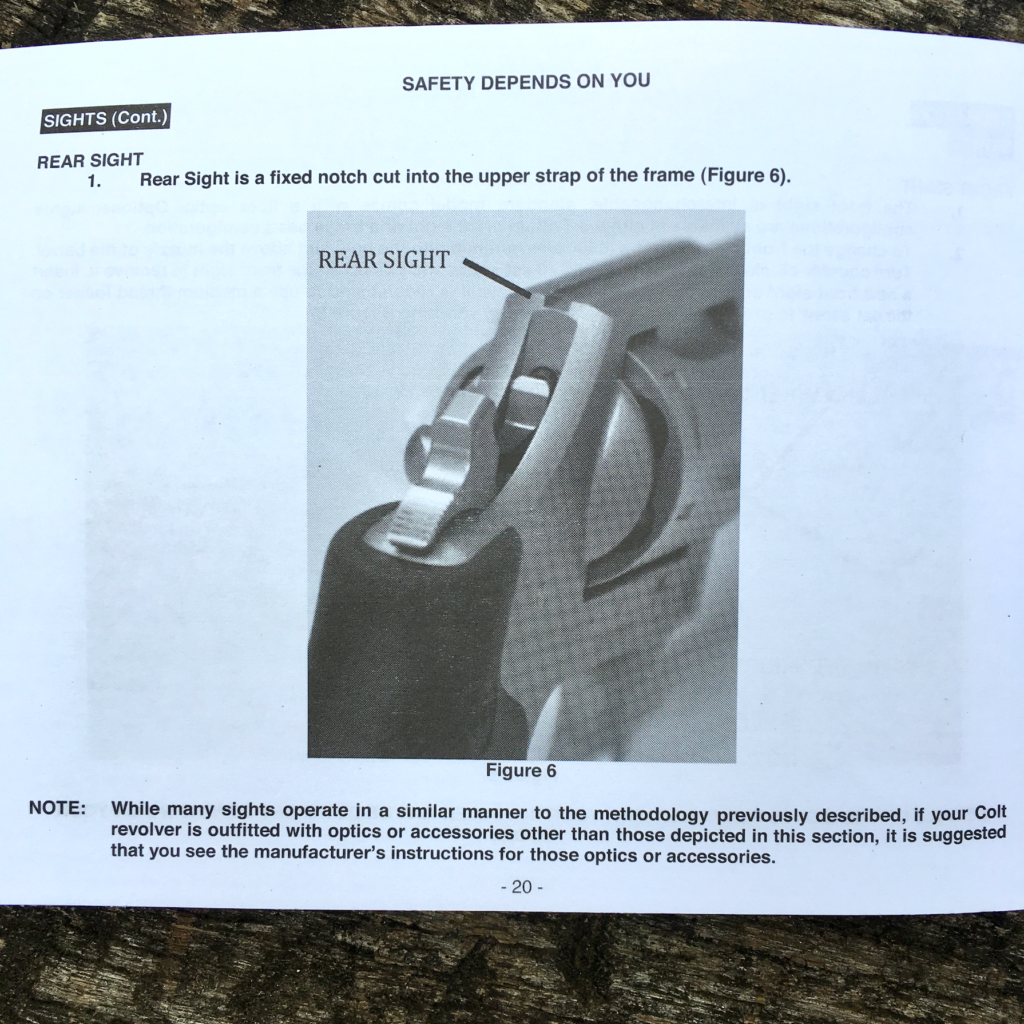
The set screw is atop the assembly and just forward of the rear blade. Without this set screw tightened the rear sight blade travels very easily. Not realizing this, during some firing the blade managed to walk several “clicks” to the left. Interestingly, the rear sight also has some positional indicators for a hasty zero; there is a single dot on the traveling portion of the windage assembly, and three coarser dots on the stationary portion.
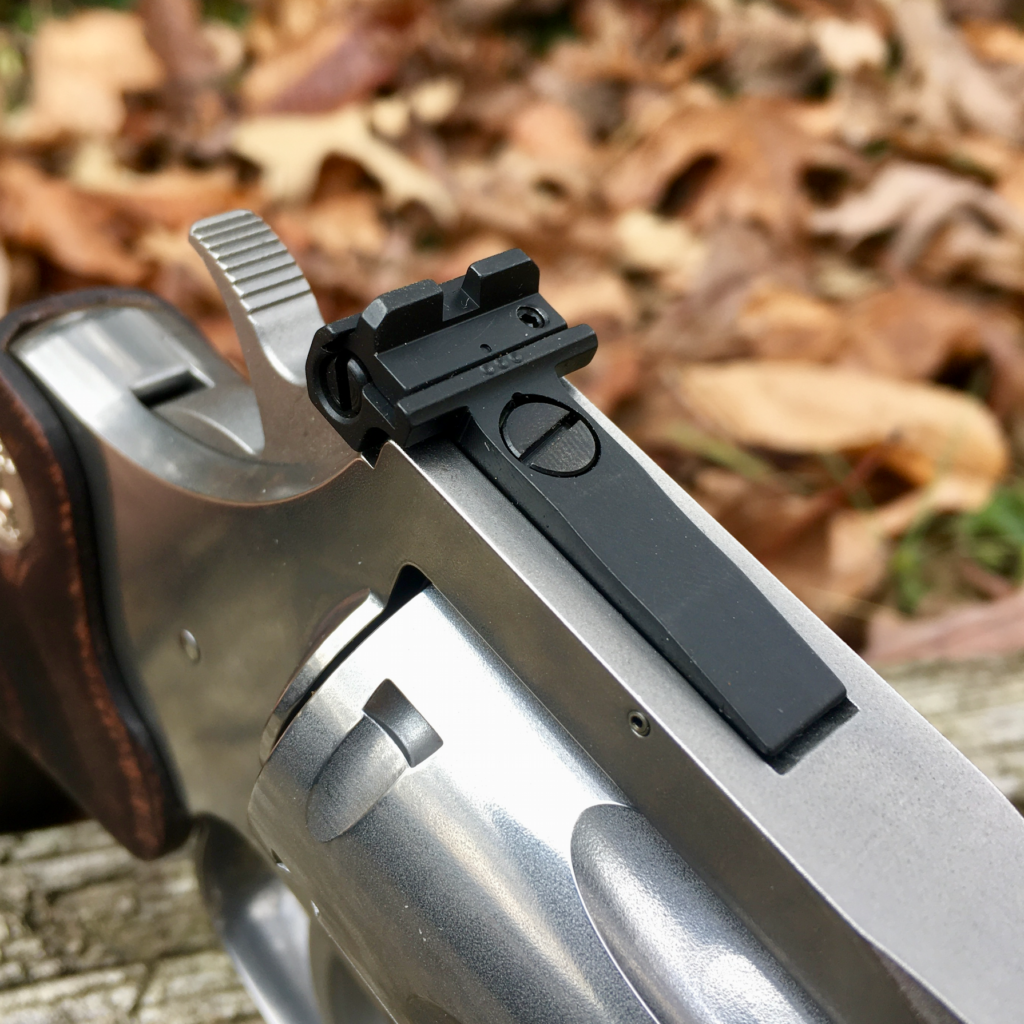
Range Sessions
This gun was such a fun shooter I exceeded our typical 500 rounds. I fired a total of 569 rounds in three range sessions from the Colt King Cobra Target. Of this I fired ammo ranging from 90 to 180 grains, from very mild .38 wadcutters, all the way up through Buffalo Bore hard-cast lead flat noses. Aside from the sight issue mentioned earlier and some minor extraction issues discussed below, the King Cobra Target functioned perfectly with everything I deigned to put through her. My range sessions broke down as such:
04 November 2019
– 100 rounds Remington 110-grain SJHP, .357 Magnum
– 5 rounds Hornady Critical Defense 110-grain FTX, .38 Special +P
– 14 rounds Winchester Defender 130-grain JHP, .38 Special +P
– 12 rounds Federal 130-grain HST JHP
– 5 rounds Speer Gold Dot Short Barrel 135-grain JHP, .357 Magnum
– 6 rounds, Buffalo Bore 158-grain JHP, .357 Magnum
– 12 rounds Buffalo Bore 125-grain JHP, .357 Magnum
– 20 rounds Super Vel Super Snub 90-grain JHP, .38 Special +P
Total: 174 rounds
08 November 2019
– 126 rounds GECO 158-grain FMJ, .38 Special
– 14 rounds Remington 125-grain Golden Saber, .357 Magnum
– 25 rounds Fiocchi 148-grain wadcutter, .38 Special
Total: 165 rounds
12 November 2019
– 150 rounds GECO 158-grain FMJ, .38 Special
– 50 rounds Remington 110-grain SJHP, .357 Magnum
– 20 rounds Speer 135-grain Gold Dot Short Barrel, .357 Magnum
– 5 rounds Speer 125-grain Gold Dot JHP, .357 Magnum
– 5 rounds Buffalo Bore 180-grain LFN, .357 Magnum
Total: 230 rounds

Function: Extraction & Ejection
One mistake I believe Colt has made with their current line of revolvers is in the ejector rod. I got a lot of questions about this on the last review, but at the time I had yet to experience the issue: the stuck ejector rod. The tip of the rod is knurled, and is every-so-slightly wider than the rod itself. This extra width can get worn down just enough to become stuck inside the ejector rod channel when “slapping” the ejector rod in a way that is conducive to positively extracting fired brass. This issue presented itself immediately with the King Cobra Target.
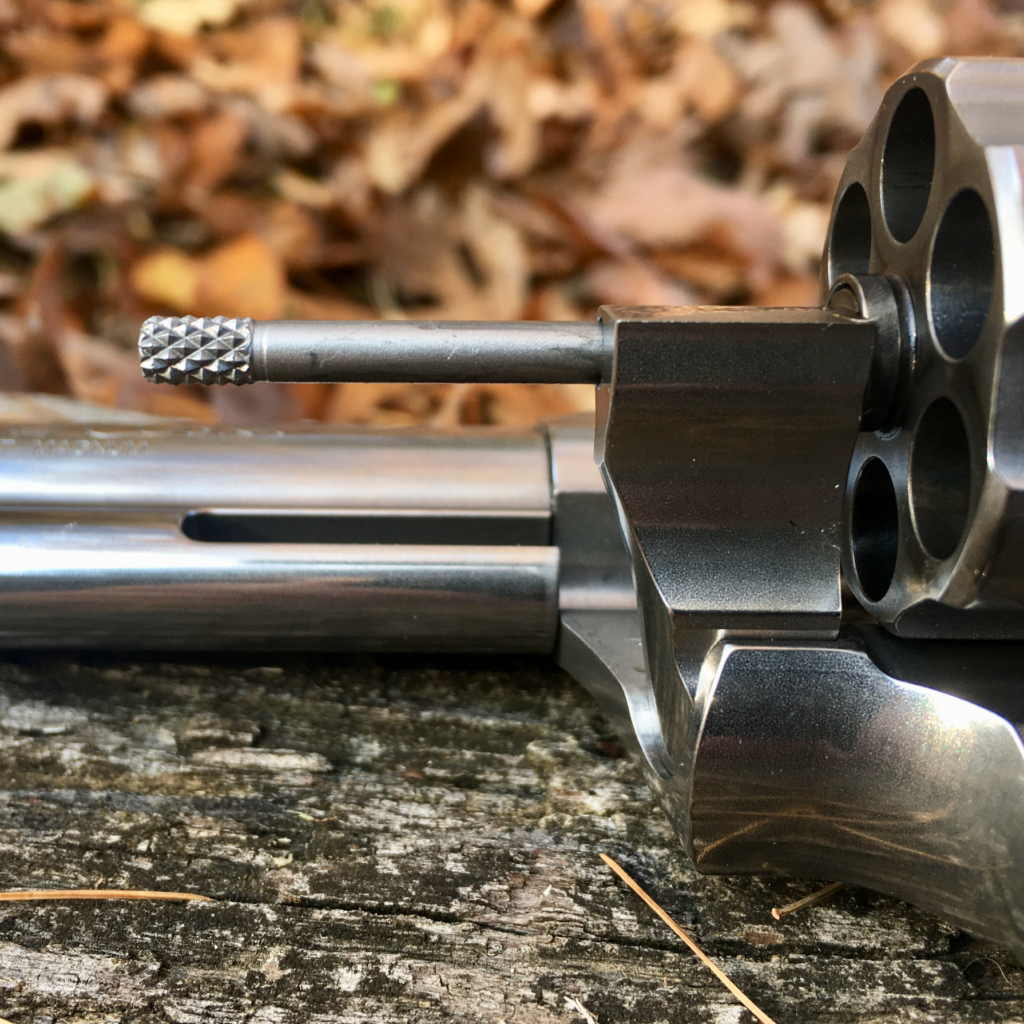
I have found that this issue is correctable, however. Simply file the knurling down to a diameter small enough that it doesn’t get stuck in the channel. Obviously I could not do this to the King Cobra Target as it was a T&E loaner, but I would recommend this mod to anyone purchasing either of these guns for serious use. Not only does it correct the sticking issue, it also improved ejector rod throw from .860″ to .910″ in my King Cobra.
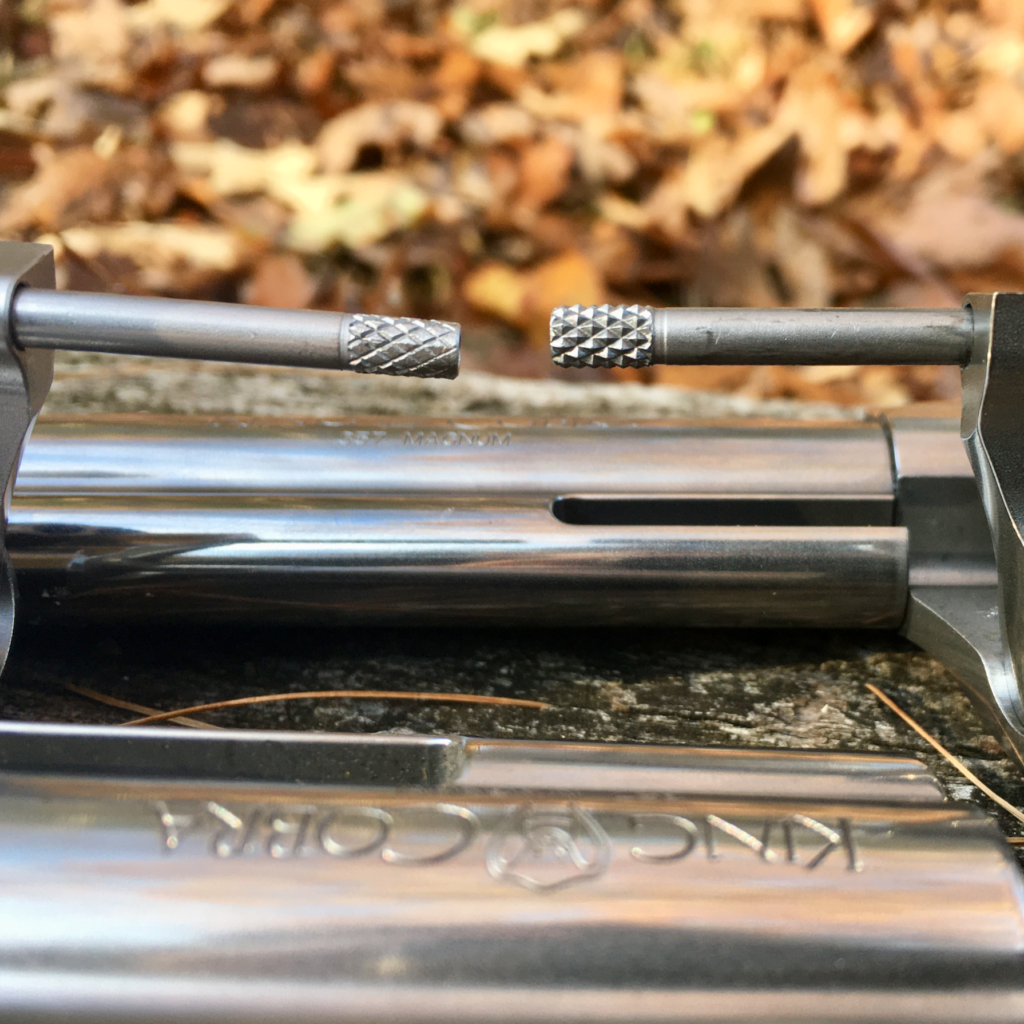
Ejector rod throw with the King Cobra Target was .860″ which is on par with other revolvers from the King Cobra line. Extraction and ejection were positive with nearly all ammunition fired. The sole exception were the few rounds of Speer’s full power, 125-grain Gold Dot and Buffalo Bore’s very powerful 180-grain LFN. There is no mistaking the Buffalo Bore’s ammunition – it is a magnum’s magnum. I found that brass could get a little sticky with these, and had to pluck a couple pieces from the cylinder. Notably, these were fired after 350+ rounds with no cleaning, which may have had something to do with it.. Otherwise I had no issues at all, despite performing no maintenance at all for the entirety of this test.
Handling
I followed our Revolver Testing Standard Operating Procedure for testing accuracy and handling. This SOP specifies firing some groups for size. Since this is a 4″ gun with adjustable sights and since its moniker is as a “target” gun, I fired groups at a full 25 yards.
Handling is assessed via the Dot Torture drill, which we fire twice: once within the first 100 rounds, and once within the last 100 rounds. While we do realize that Dot Torture is not intended as a handgun test, it does demonstrate something about accuracy, transitioning the gun from target-to-target, firing multiple rounds, firing with both hands, together and individually. Because I did not have a holster that fit this revolver, all drills called to be fired from the draw were fired from a compressed ready. Reloads were conducted with a HKS 10 speedloader.
The first iteration of Dot Torture was fantastic! On my first range trip I fired four cylinders (24 rounds) through the King Cobra Target to adjust the sights and get a feel for the gun. Then I jumped right into the drill with a middle-of-the-road .357 Magnum load: Remington’s 110-grain SJHP. I managed to pull a 49 of 50 possible at four yards Not bad at all!
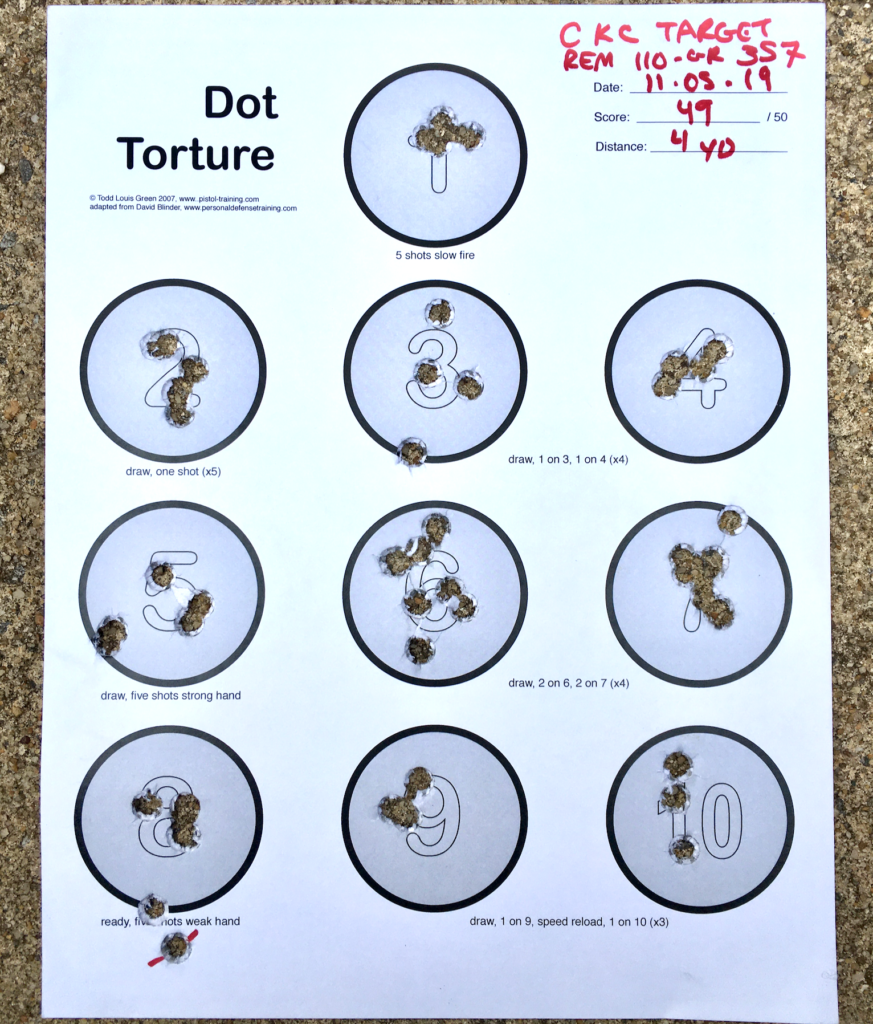
My second iteration of the drill was fired from five yards. I’ll be honest with you guys: it was not my best work. I would ask you to lay the blame on me, where it belongs, and not on the gun. My final score 46 out of 50, this time shooting at 5 yards. I thought about re-shooting because this clearly was not the gun’s fault, but I felt weird about that, too.
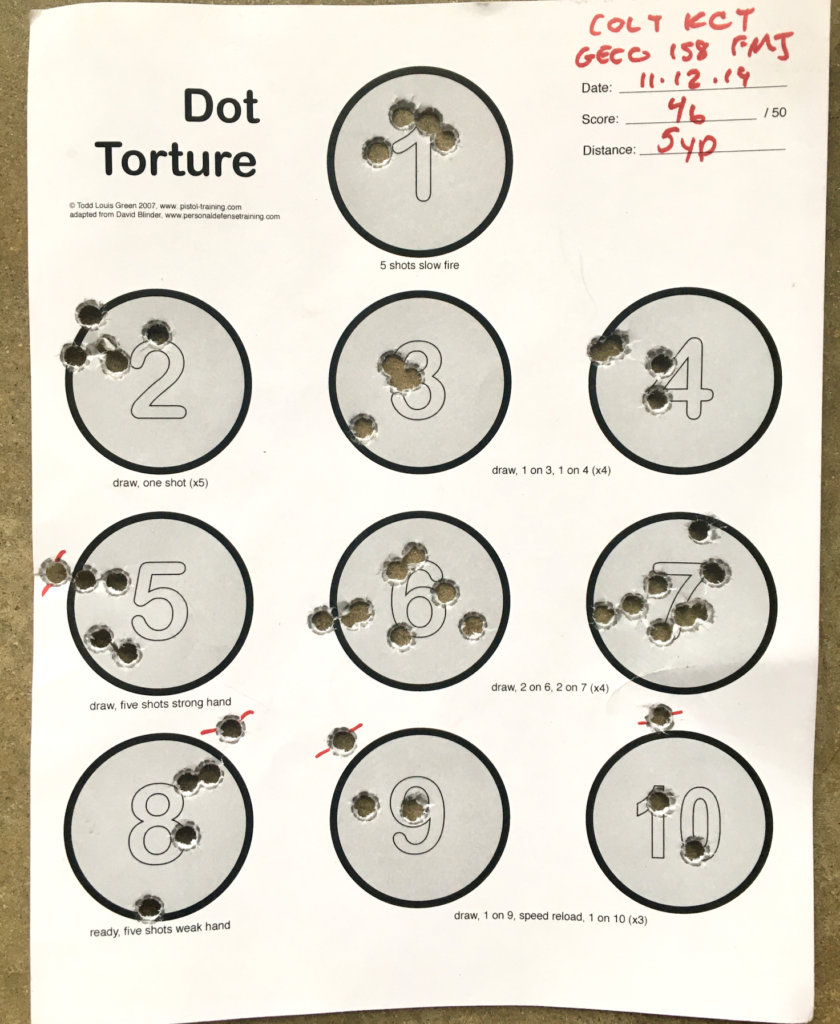
I found the King Cobra Target to handle well. The heavy barrel places just a bit of weight toward the muzzle, but not overly so. The gun is still well balanced and points well.
With regards to recoil: one definitely feels .357 Magnum ammo. On my scale the King Cobra Target came in at 34.8 ounces, a bit light for the heavy stuff. I fired ammo along the power spectrum, from full wadcutters all the way up to Buffalo Bore 180-grain LFNs, and about every “level” in between. The King Cobra Target is comfortable with everything with a “.38” stamped on it. Once you dip your toe into the “Magnum” realm things get a bit more sporty.
With the lighter Magnums, namely the Speer 135-grain Gold Dots and Remington Golden Sabers, recoil was manageable. I wouldn’t be mad at an experienced shooter choosing to carry these for defensive purposes. I found the full power Magnums (Speer Gold Dots and the Buffalo Bore fodder) fairly unpleasant to shoot, and had to cajole myself into firing a second cylinder of Buffalo Bore 125s for a group.
Accuracy
For accuracy I wanted to test this gun as near as possible to its most probably use-case(s). Being a small-framed (but medium-sized) revolver with a 4″ barrel, it’s safe to assume this gun will be used for some defensive purposes. I recorded two defensive .38 Special loads, two defensive .357 Magnum loads, and just for grins (or grimaces) a full-on, top-end Magnum load. All groups were fired from standing at 25 yards, in double-action. All groups were also fired with the OEM, fiber-optic sight.
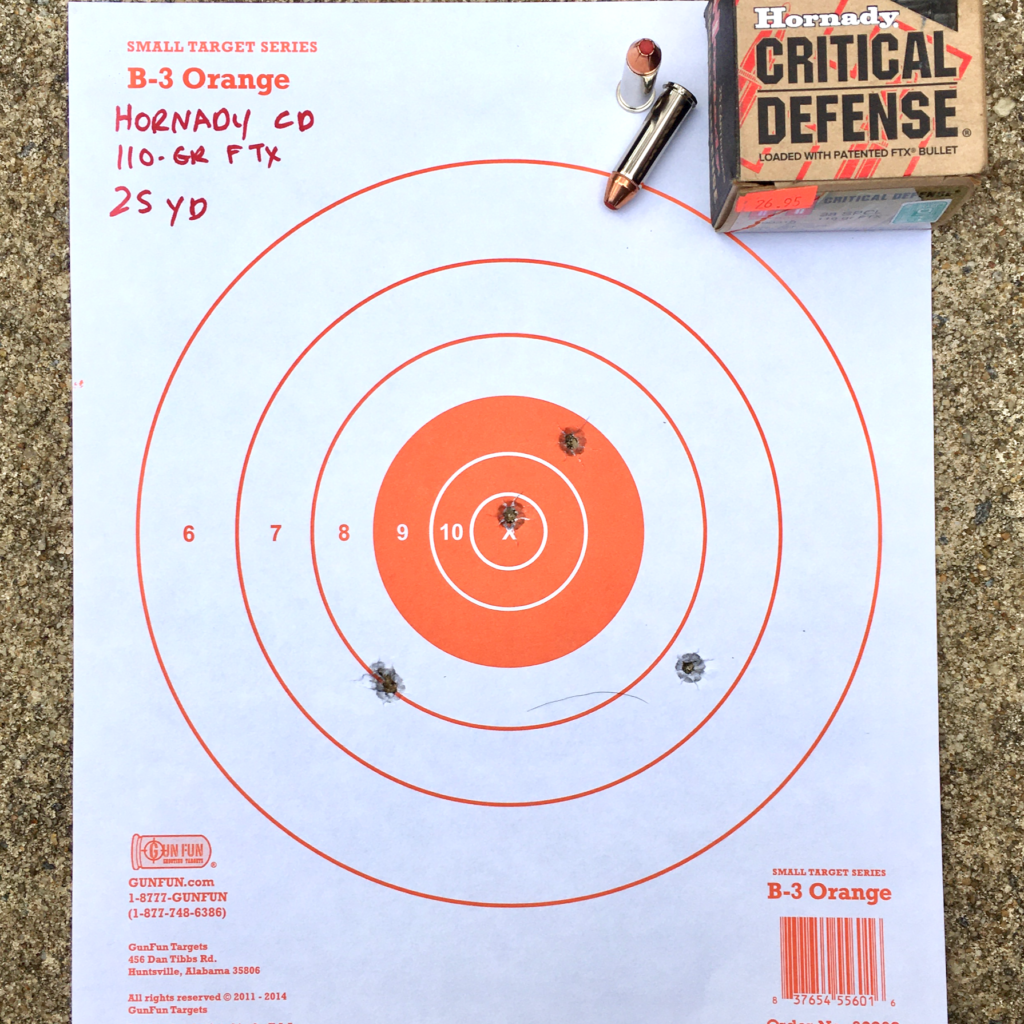

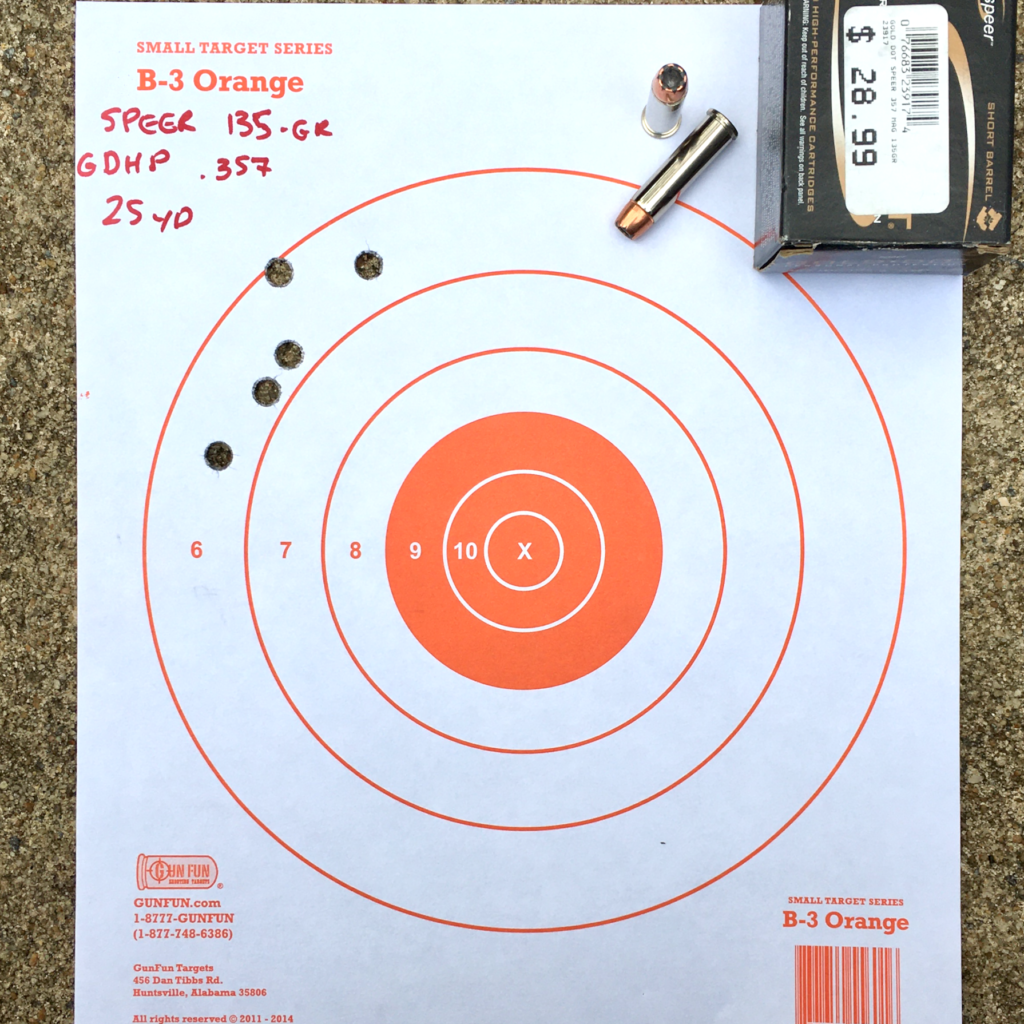

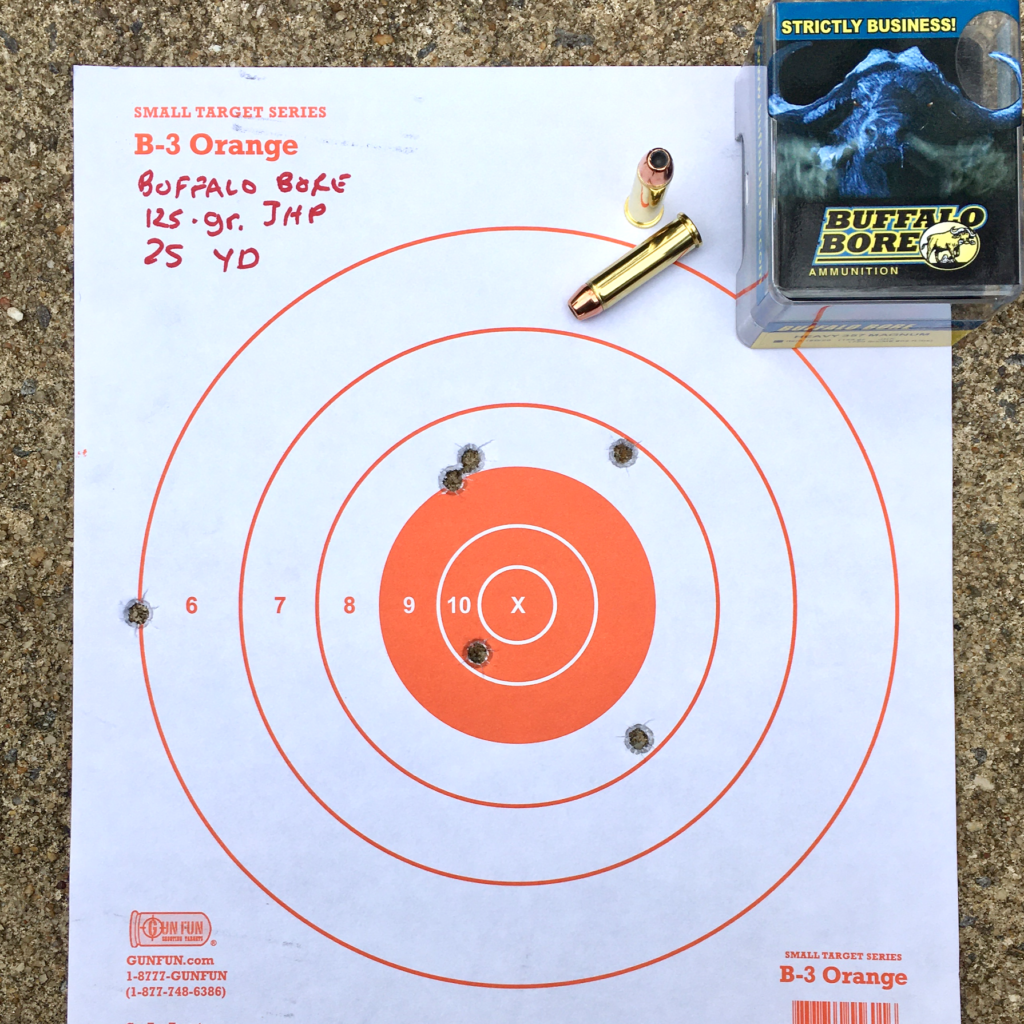
Just for the sake of curiosity, I fired one more group, this time in single action. The double action groups were pretty good, so I wanted to see what I could do in target mode with a target load. With Fiocchi’s 148-grain wadcutter in single action I was able to produce a 2 1/4″ group.
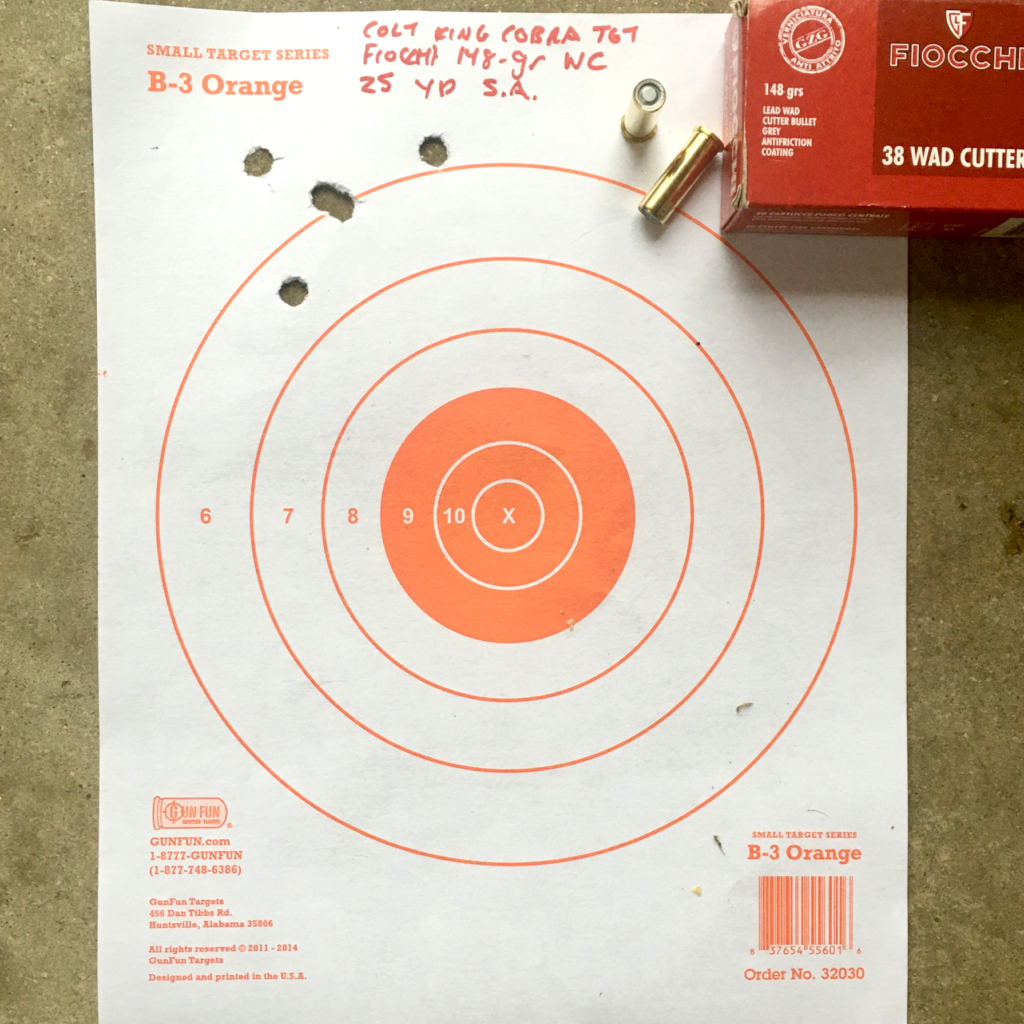
I was extremely pleased with the accuracy of this revolver, which is enabled by the phenomenal trigger and upgraded adjustable sights. As readers have pointed out in previous reviews, these groups could certainly be tightened by resting the gun and firing in single-action, but I don’t feel that test reflects how the gun will be used and am far more interested in practical accuracy.
Function: Trigger
The Target model’s hammer and trigger are the same narrow hammer and trigger found on the standard King Cobra, as well. Again, I was somewhat disappointed by this; on a “Target” model I had hoped to see a wide hammer spur and more importantly, a better trigger.
Normally when I say a revolver needs a “better trigger” I mean that the internals operated by the trigger need polishing, tuning, or outright replacing. Here, though, I literally mean the trigger. The trigger common to both variants of the King Cobra with which I am familiar is narrow and square-edged. The edges are beveled, but are nothing at all like the curved trigger found on most modern double-action revolvers.
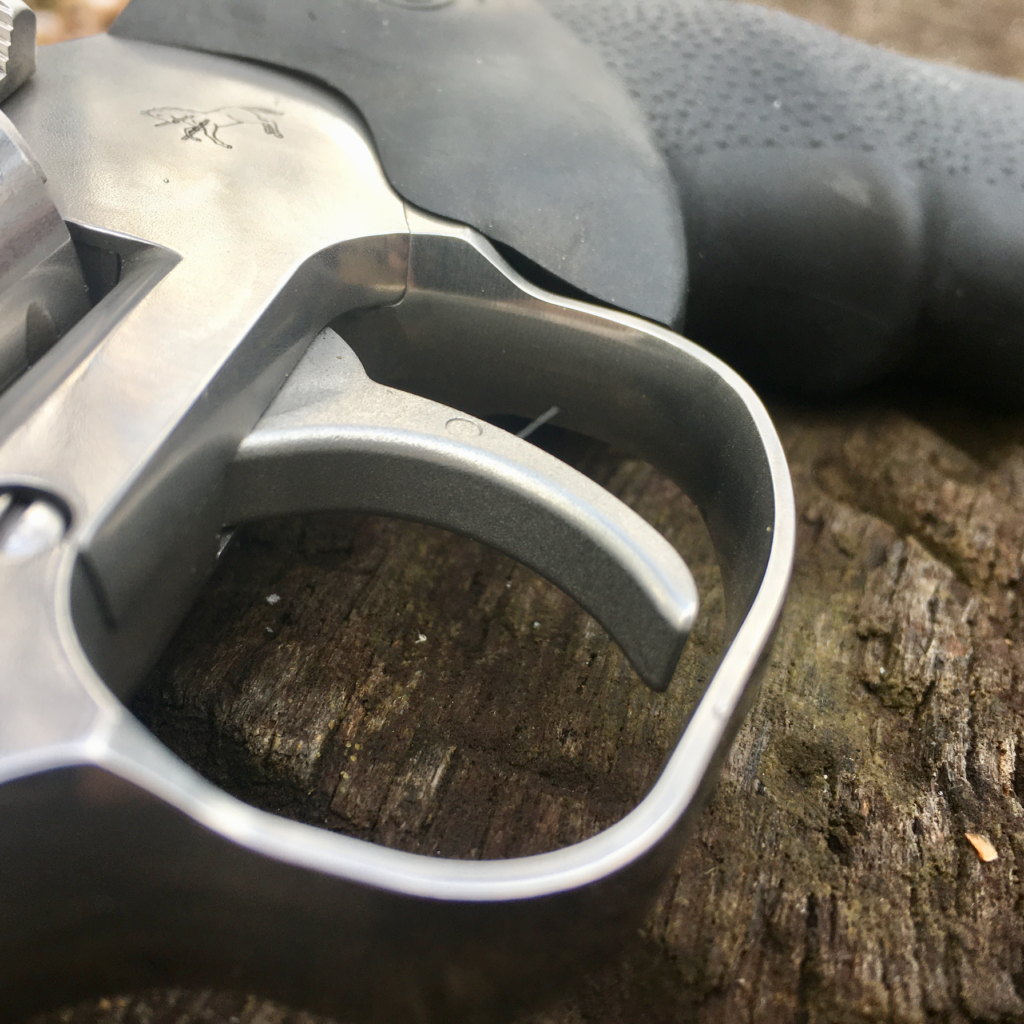
I draw such a hard line because north of around 175 or so rounds the gun becomes painful to shoot. I mentioned a “tingling” in my trigger finger when reviewing the 3″ King Cobra. After all sessions with the King Cobra Target the pad of my right index finger was a bit tender. Colt is probably playing the smart odds that most owners won’t fire 100 rounds in the gun’s lifetime. For the rest of us, I do feel that this gun needs wider trigger. If not as an OEM part, I would at least like to see one made available as an aftermarket option.
On to the good news: trigger weight and pull! I measured six single- and six double-action pulls with the King Cobra Target. I was duly impressed. Double-action pulls averaged a beautiful, silky-smooth 9.25 pounds. Weirdly the single-action pull was heavy, both proportionally and absolutely. It clocks in at five pounds, over half of the DA pull. Despite its weight the single-action trigger is incredibly crisp. There is no creep, no mushiness, no grittiness – just a solid wall, then a break. The King Cobra Target’s trigger is every bit as smooth as the 3″ King Cobra had primed to expect, and allows one to make full use of its excellent sights.
How Good Is the Trigger?
I saved the trigger stuff for last for a reason. I wanted to come up with a way to quantify just how awesome this trigger is, so I conducted two informal comparisons. Since I also have two S&W revolvers on loan (reviews coming soon!), a 10mm 610 and a .22 Magnum 648‡, I decided to press them into service for comparison. First, I wanted to see how much difference was made by using single versus double action. I feel shooting in single action goes a long way toward “norming” the triggers of various revolvers.
Test #1: I shot five-shot groups with both the 610 and the 648, in both single-action and double-action. I measured them and compared the group sizes. Then I averaged ALL of my double-action groups with the Colt King Cobra Target (including all fliers) and compared it to my sole single-action group.
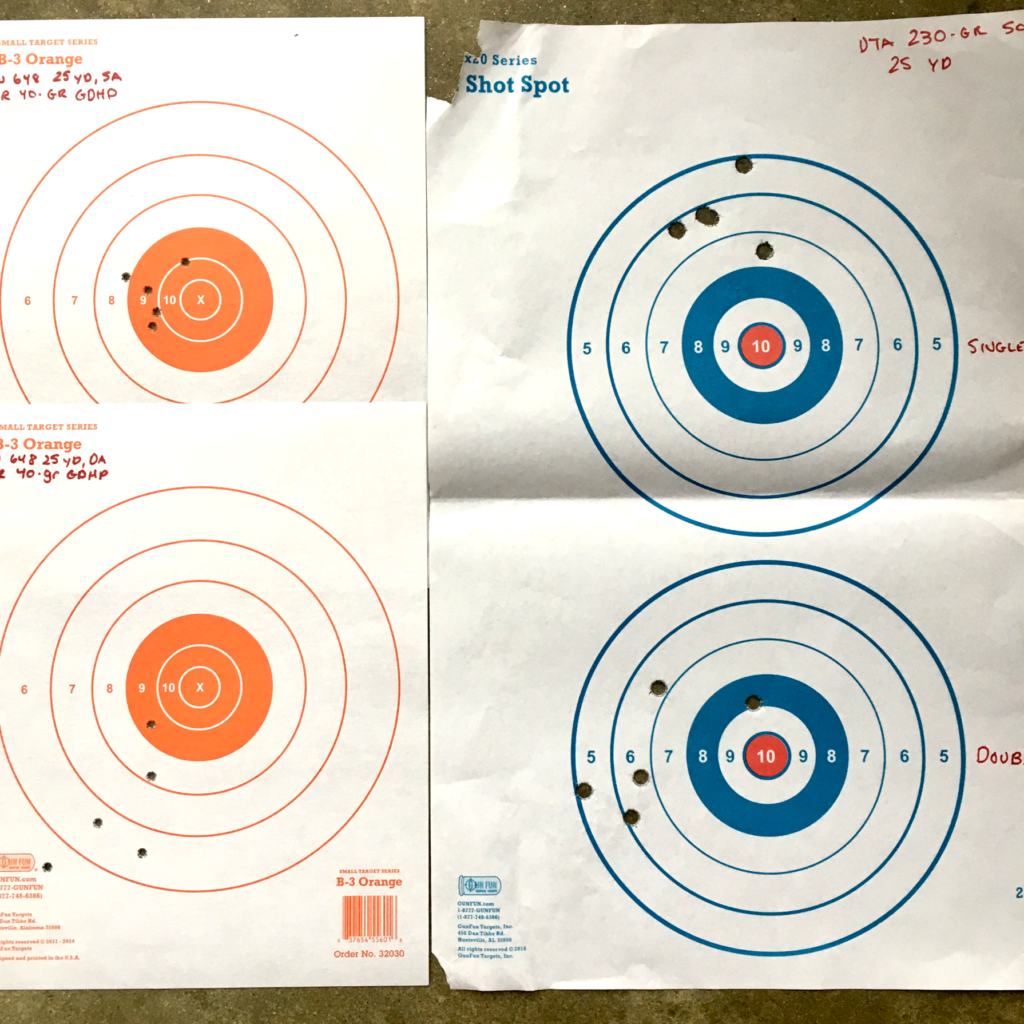
The average double-action group size with the King Cobra was 3.775 inches. Shooting in single-action I was able to shoot a 2.25-inch group, an improvement of 40.4%. With the 610 my single action group was 3.125 inches, and my single-action group was only 1.5 inches, indicating an improvement of 52% when using single-action. With the 648 my double-action group was 4″ and my single-action group was 1.8125 inches, an improvement of about 55%.
What does this mean? It means there’s still something to gain from using single action with the King Cobra Target, but that gain isn’t quite as big because the Colt’s double action trigger gets much closer to single-action capability. I actually consider this test successful; the Colt’s DA trigger is capable of some serious work.
Test #2: I wanted to shoot as fast as I could shoot accurately and see if any differences emerged. I only did this test with the King Cobra Target and the 648, mainly because the 648 was the only other gun I had with me when I thought of this test. I loaded up both guns. At three yards I fired them as quickly as I could and recorded my time. My target is below.
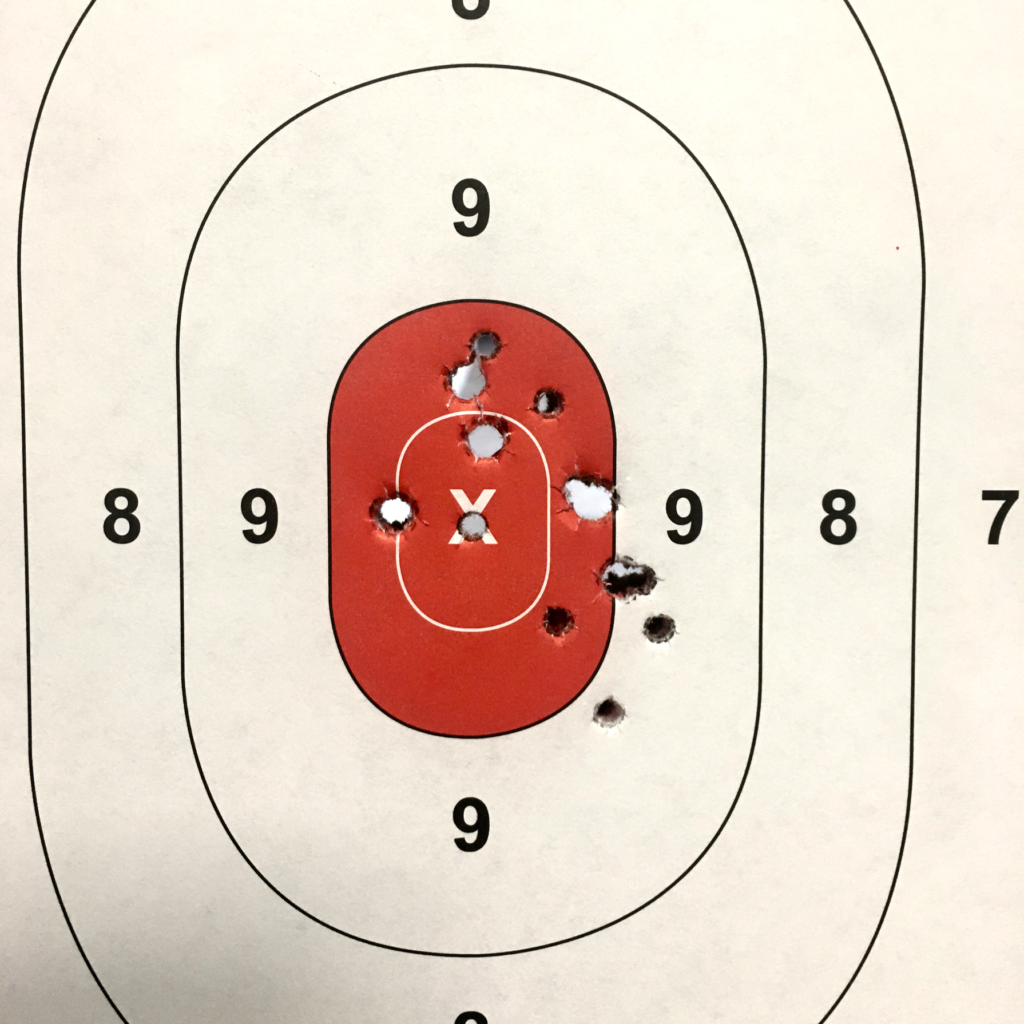
What can we learn from this target? Unfortunately not much; my results here weren’t as definitive as I had hoped they’d be. Let’s take a look anyway. My overall time with the King Cobra was 1.73 seconds. My overall time with the 648 was 2.76 seconds. Now, that’s apples-to-oranges because I fired eight rounds from the 648, and it doesn’t take into account my differing lags between the buzzer and the first shot (which I dropped from the averages), so let’s look at the splits.
The average split for the King Cobra Target was .262 seconds while the average for the S&W revolver was .298 seconds. With the King Cobra Target loaded with .38 ammo I can fire splits of roughly one quarter of a second, while the best I could manage with .22 Magnum 648 was about one third of a second.
There’s nothing definitive in this last test, unfortunately. The difference between .262 splits and .298 splits? Yeah, no one is going to notice or care unless you are competing at the absolute highest levels. And that is the difficulty in trying to explain a magnificent trigger from an OK one; I’m just trying to take a physical feeling and find a way to turn it into numbers. I’m not sure I succeeded to my own satisfaction on that count, however. Hopefully you got something out of this, even if it was just a chuckle at my misguided attempt!
The Bottom Line
I was – and remain – absolutely smitten by the 3″ King Cobra. It is an almost perfect concealed carry revolver, at least to my eye. The King Cobra Target is every bit as good as its smaller incantation. Of my two complaints about this gun, one is old and one is new. Like the older 3″ King Cobra, I wish this revolver featured a wider, more comfortable trigger. Unique to this model is a grip that places form over function, but that problem is easily rectified. Ok, three complaints: there should be some Loctite on that sight screw, too.
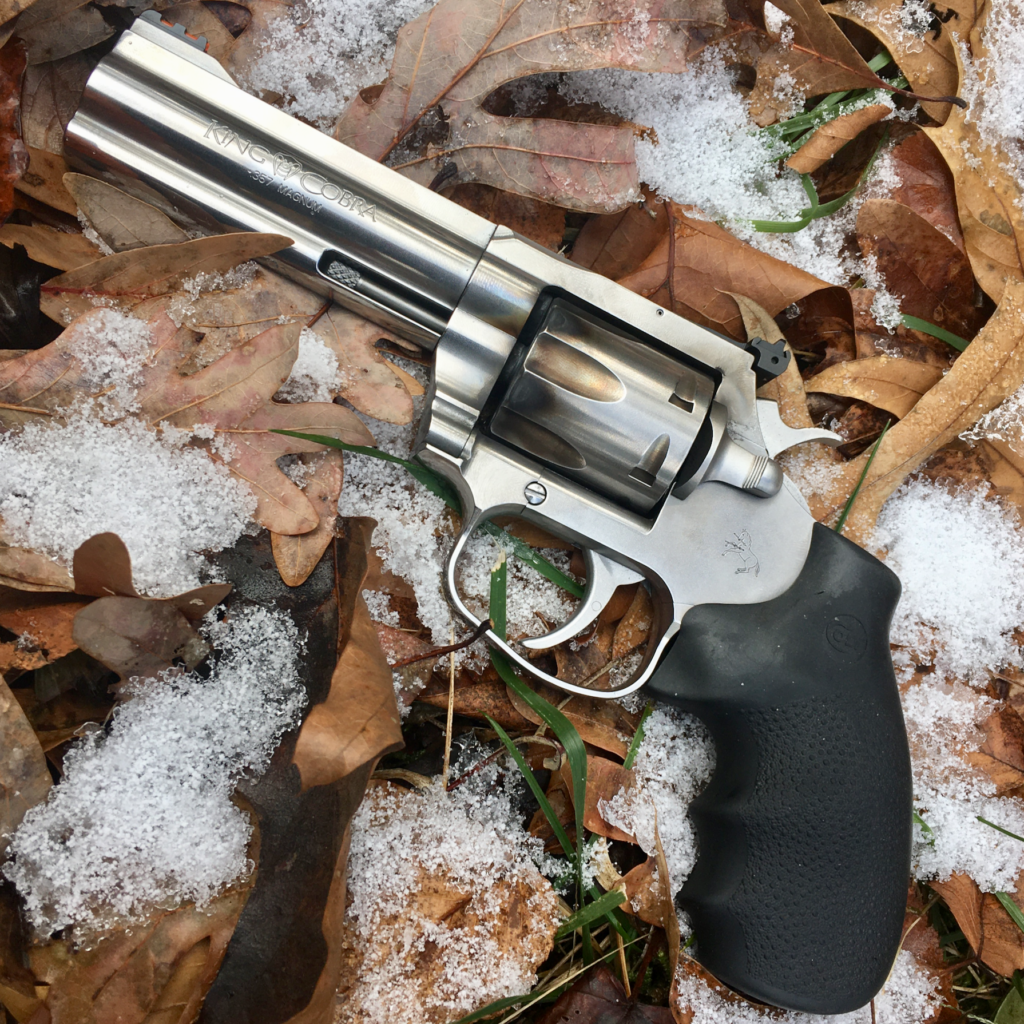
The newer King Cobra Target is a phenomenally accurate and shootable gun. I am extremely happy to see that same, amazing trigger present on the the Target variant, and the adjustable sights are a very welcome addition. I was surprised by some of my own groups with this gun and wish I’d had the opportunity to stretch its legs just a little more. If I were in the market for a mid-sized revolver, the King Cobra Target would make a fine trail or camp companion, bedside revolver, perhaps a light game hunter, and of course, a target revolver.
Support revolver Reviews Like This one!
I would like to offer a huge ‘thank you’ to our Patrons! You guys make reviews like this possible. Each one of these reviews costs several hundred dollars and many hours of time. We are not kidding when we say we couldn’t do it without you. Thank you! If you aren’t a Patron, please consider supporting RevolverGuy!
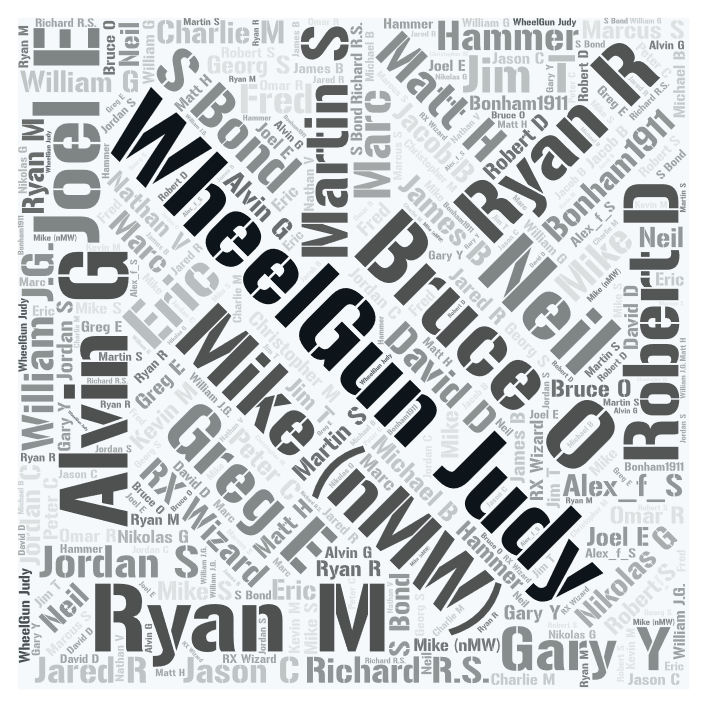
†I realize that firing successful stages on Dot Torture without a front sight seems implausible. . . and most likely I had a front sight for the whole thing. However, I’ve twice seen competitors shoot an entire stage without a front sight and have excellent runs. This wasn’t on purpose; in both instances the sight had fallen off at some point in the previous stage. The brain had taken over by putting the gun where it needed to go…as long as they didn’t think about it too much.
‡It is important to point out that I am not beating up on the 610 or 648. I actually like both more than I thought I would. However, the double-action triggers on both of these guns are four and five pounds heavier (respectively) than that of the King Cobra Target. Interestingly, both of their single-action triggers are also about a pound lighter than the King Cobra Target’s.

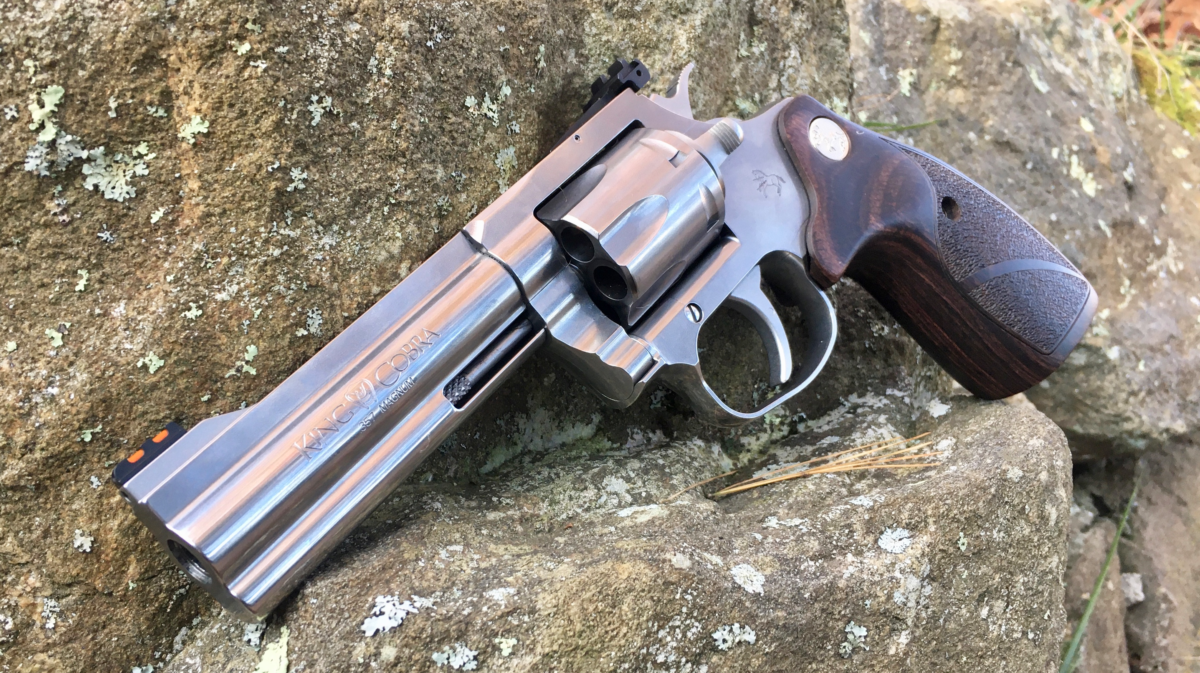

This Colt would be tempting, if I did not already own a GP100 with a 4.2” barrel. That gun’s trigger is heavier and not as smooth, though ours has gotten smoother with use.
I also love K Frames, the “just right” size, but the heftier frame of the GP makes it my woods gun, instead of my S&W 64-3, which is for home defense. My wife manages the GP as expertly as the 64, as the weight is not a problem and she like the grips on the gun. She prefers +p from the GP; neither gun packs .357 for home duty.
Do you think for home defense, this Colt offers a better all purpose-gun for everyone in the family, rather than a larger framed Ruger or Smith?
Another excellent review!
An interesting comparison would be the 3” King Cobra with the 3” Kimber K6S.
I totally agree! That may be possible at some point; currently we don’t have a Kimber and a Colt in the same place. I’ll see what we can do about that.
I handled one of these in store yesterday and that trigger definitely stood out along side the slimness. Its great to see Colt giving S&W a run for their money compared to the rereleased K frames.
Thanks for the review. I really like having the SP101 with a 4 inch barrel (though I don’t use it for carry), and it is nice to see Colt (and now Kimber) offer similar carry-frame guns with 4 inch tubes. The only issue now is that I want the Colt or the Kimber (I still can’t decide which appeals more) in all three barrel lengths.
Personally the 3″ version is still the Goldilocks gun. If only they made it with adjustable sights…
I have to admit that I have a hard time getting passed how shallow the rear sight is on the fixed sight Cobras and King Cobras. I don’t think it is any worse than a Smith, but it is definitely more shallow than my SP101. If the adjustable sights could be locked in place liek the Bowen Rough Countries, then I would be all for that.
Or I would totally welcome a Novak-style sight like those on the WC GP100 or the Kimbers.
I do wish fixed revolver sights were better (almost universally). On the other hand, the results speak for themselves…
Also, I noticed that your 3 inch King Cobra now sports a bobbed (and presumably DAO) hammer. Were you able to get a replacement hammer to modify or did you have to change the original?
I bobbed the hammer myself. I will let you guys know how that went in an upcoming follow-up.
Justin, thanks for such a thorough and excellent review! There’s none like it, anywhere else.
As you discussed, in an earlier era, a “Target” designation would usually indicate a gun with several unique features, such as: Upgraded, high visibility, adjustable sights; Target-style stocks; A wider trigger face, possibly grooved; A redesigned hammer spur, optimized for SA fire, and possibly; An improved action.
Colt’s obviously nailed the sights on this one (minus the LocTite—Come on, guys!). Since the baseline gun already has an excellent action, there wasn’t much work to be done there (at least within the bounds of a mass production, non-custom gun).
The new stocks also check the box, and they suffer the malady common to most “Target” stocks. The S&W Targets were the same, narrowing too much at the neck, which is why most of the old wood was immediately replaced by rubber—especially in police holsters. I think these stocks were designed to facilitate SA fire, by letting the hand ride up under recoil, where the thumb could get to the hammer spur easier—kind of like the SAA.
Alas, most revolver shooting is done in DA these days, even in the sports. A hunter will appreciate the SA capability, but most defensive or sport shooters will run it in DA, and could benefit from a better grip design. For every SA Bullseye or PPC shooter out there, there’s probably a half-dozen IDPA, IPSC, or ICORE shooters who will trigger cock the gun. Colt’s followed tradition with these Target stocks, but I agree they won’t serve most shooters well.
I disagree slightly about the trigger. I think Colt’s probably made a good choice to retain the narrow, “DA” trigger face of the baseline, New King. I don’t like square edges on a trigger face, so I agree with you that those have to go, but I’m hesitant to ask for a wider, SA blade. It would have been traditional to do so, but I’m glad they kept the narrow, DA trigger on this gun, since that’s how it will be used most frequently. I’m really glad they didn’t groove it! Your suggestion to offer a wider trigger as an optional part is a good one, but I’m glad it’s not the standard on this model.
I’m also glad they didn’t add an exaggerated Target-style hammer. This will make the gun more useful as a carry gun, or a sport gun for one of the action/defensive games. It’s less likely to hang up on something, coming out of the holster, and that’s good.
Absent the stocks (which probably bear the stock maker’s design influence, much more than Colt’s) you could almost say that Colt’s did a great job of designing a Target gun for the modern era. Since SA fire no longer rules the day, they eliminated the traditional features that catered to it, and instead went with more modern, DA features. I like that!
It’s good to see Colt’s back in the game with such a variety of models! I can’t wait to see where this trend goes, and I’m proud that RevolverGuy is leading the way on reporting about it.
Actually we don’t disagree about the trigger. Sorry if I was unclear; I do not want a SA-style trigger. However, I do think Colt’s needs to come up with something – something on par with the triggers seen in Kimber, Ruger, S&W, and even Taurus revolvers – that is not unpleasant after 10 minutes of dry practice and not painful after 150 rounds of live ammo. I’ve had different issues with other revolvers, like triggers so heavy they tire my finger. This is the first one to cause actual pain to the point that I’m self-limiting my practice time with it.
And to be honest, we don’t disagree about the hammer, either…mostly, haha. I agree, I wouldn’t want a full target hammer. I would like to see a semi-target hammer, though.
Are trigger shoes just for competition guns, or combat weapons? I’ve seen a photo of a Korth with a “combat trigger shoe.” I wonder if that might solve the issue you had. Pain after 100 shots is rather extreme.
I just shot 100 .38 std pressure rounds out of two different snubs, without any suffering.
I know you don’t plan on keeping it, but if you did, I suspect a trip to the polishing wheel would be in order, to get rid of the squared edges on that trigger. That would probably make a huge difference. I’ve had to do that on a number of S&Ws. A trigger definitely should NOT hurt!
A well radiused trigger, essential to comfortable and precise manipulation, and a smooth countoured spurless hammer shall not be infringed upon by factory MIM technology. Even MIM can make a .375″ hammer spur for target models.
On every DA revolver I have – S&W and Ruger – each trigger has been totally radiused (think half moon) and polished both internally and externally. The S&W serrated revolver triggers are a particular target of priority alteration.
That adjustable rear sight looks rather well thought out. Appears to have the toughness of the Ruger with the adjustability of the S&W. It should definitely be offered on the 3″ barrel versions as an option.
On the ejector rod issues, one would have thought Colt would have put a larger knurled bulb on the end of the ejector rod like on the old Troopers. Maybe their design team wasn’t familiar with the I-Frame and V-frame Troopers of ages past.
Since it’s built on a modified D frame, it will be interesting to see how a steady diet of .357 Magnums, especially in the 125gr bullet weights, affect the guns.
Now if Colt would reintroduce the V and AA frame .357s . . . . those guns were brute strong.
I will keep you guys in the loop as to how the 3″ King Cobra holds up. I plan to keep shooting it and shooting with some Magnum ammo. As I said, it gets a little lively, but I’m kind of curious about that, too. I’m also just generally curious about how these guns hold up over high round counts. I have a follow-up article on the King Cobra planned for sometime in January or February.
I totally agree on the larger ejector rod bulb.
Justin,
Great review! Great groups!
I would be glad to bring a 3″ GP 100 and 3″ SP 101 for comparison with the King Cobra and a 6″Gp 100 for good measure.
Sorry those great looking stocks didn’t work out!
There is something great about a 3″ barrel!
It occurs to me that this gun is sort of a modern day Diamondback.
Do you think this is as close as we’ll get to a modern-day Python?
Time will tell!
Great blog. I’ve read and enjoyed all your articles.
I know you’ve resisted bench resting guns. While your standing shots at 25 yards reflect how the gun does for you in pratical shooting, a benchrest test would give readers an idea of what smaller groups the gun is potentially capable of for them (if they can shoot well).
It is your money, your time, and your choice. I’m just hoping you can see the utility of showing readers that a given gun is capable of at least 2.1″ groups at 25 yards, for example. That would be more informative than only showing it can get 4.0″ with a particular load. Where we don’t know if it is the load or you.
Nope. Sorry. If you’d like input on how we put these articles together, please consider supporting us via Patreon.
EDITED TO ADD:
I will talk about my reasoning though. There are essentially four reasons I view bench-rested groups as having little actual value, beyond giving nerds (like me, and probably you) some cool numbers to obsess over:
1. Unless a machine rest is used (which is completely out of my reach) there is still human variation in the groups,
2. Even though my bench-rested groups aren’t great, I doubt very many shooters are going to be capable of reproducing them in field and/or defensive conditions,
3. Just because THIS exemplar shoots a 2.1″ group with X load doesn’t mean yours will; each owner is going to have to do that work for him or herself, and
4. Unless you are competing in a bench-rest competition, the difference between a 2″ and a 4″ group at 25 yards is pretty much academic for any practical purpose I can imagine.
A 3″ with adjustable sights….oboy~! But, I dream!
Don’t we all!
It appears that the frame has been damaged during the extension firings.
This becomes apparent in the photo with the dirty barrel when compared to first photos before firing.
The frame where the flat head screw is on the left side, indicates a frame misalignment.